22 Rome: From Republic to Empire (750 B.C.E. – 468 C.E.)
Cynthia Smith and Nadejda Williams
INTRODUCTION
DISCOVERY — Roman Concrete
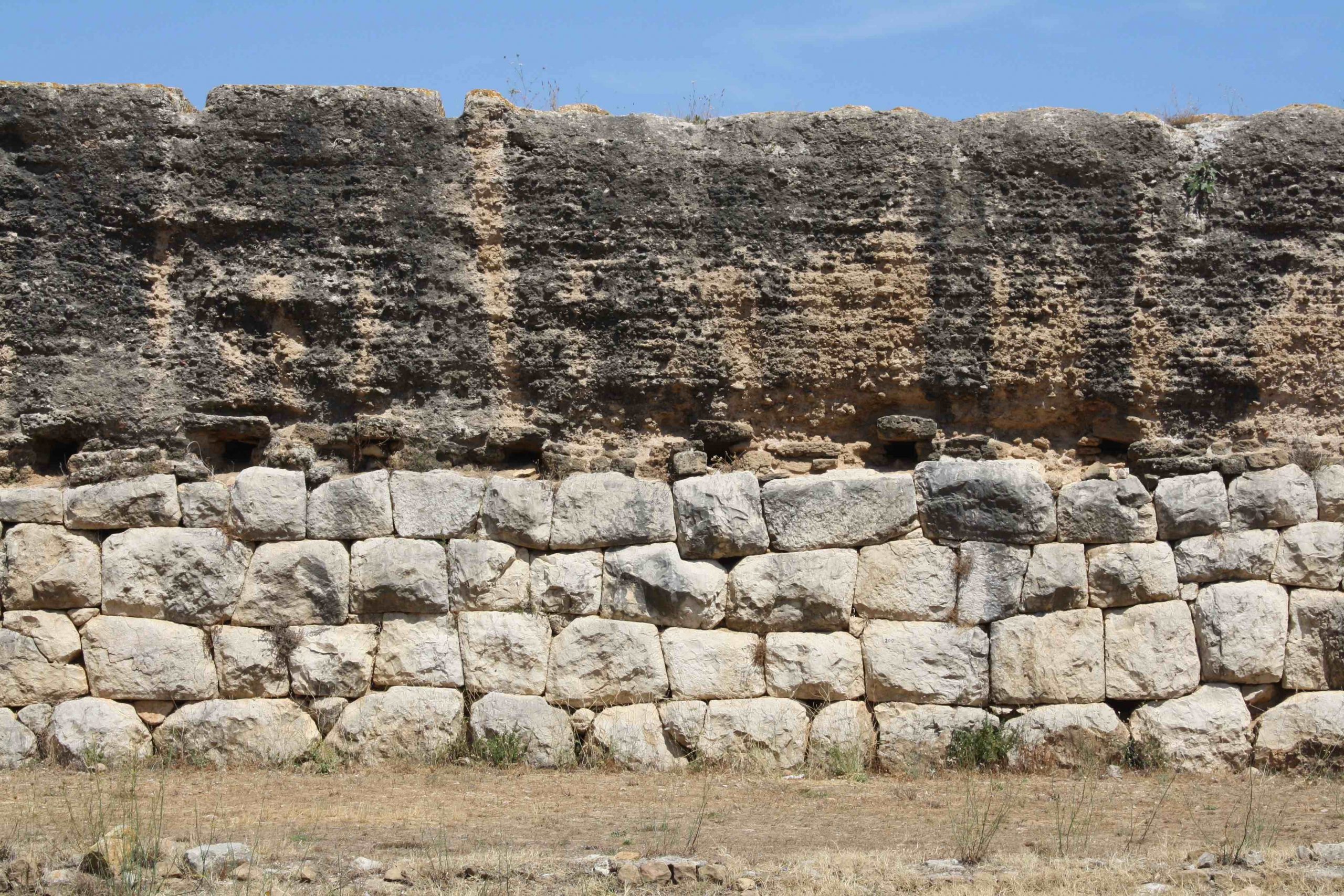
The ancient Romans were great builders and ruins of their construction are visible throughout Italy as well as in numerous regions once controlled by this vast empire. It might surprise you to learn that concrete, a product associated with modern life, was a crucial aspect of ancient Roman construction. The strength and longevity of Roman concrete enabled them to build long-lasting piers and seawalls with some maritime structures still intact after 2000 years. In comparison, modern concrete sea structures generally last less than 50 years before seawater causes erosion. To discover the secrets of Roman concrete, a team of engineers and geologists analyzed core drillings from the remnants of ancient construction in Pozzuoli Bay (Naples, Italy) in 2017. What they found was remarkable.
Ancient Roman concrete was made from a mixture of quick lime (calcium oxide) and a local volcanic ash that possessed a unique mineral make-up. This ash was mixed with lime and poured into wooden frames to create sea structures. As cracks emerged, seawater seeped in and mixed with this specific kind of ash, creating a chemical reaction that generated intense heat and produced rare minerals. These minerals formed crystals that actually grew inside the concrete, filling in cracks and binding the concrete together, making it stronger than the original mix. It is believed chemically active concrete structures remained hotter than the surrounding water for at least two years after construction. The resulting strength and longevity of Roman piers and harbors fostered the empire’s ability to maintain its imperial reach, and fostered lucrative maritime connections.
Not only was Roman concrete far more durable than anything produced later – including in the present day – but Roman processes were more sustainable. Less heat was required, thus less fuel was needed. Roman processes also used far less lime than modern mixes. Modern concrete, made up of limestone, sandstone, ash, chalk, iron, rocks and sand, erodes in seawater within decades, requiring steel reinforcements which then also corrode over time. Modern production requires significant heat which generates substantial CO² emissions. In comparison, contemporary concrete production generates an estimated 5 to 7% of global CO² greenhouse gas emissions. We have yet to match the Roman ability to produce and use concrete effectively, economically, and with limited environmental impact. While we cannot replicate Roman materials, scientists are working to apply knowledge from recent discoveries to improve modern concrete to be more durable and less environmentally costly. As we seek to reduce greenhouse gas emissions, and work to protect coastal communities from rising seas and floods, the ability to build maritime structures that use less fuel and that can withstand sea erosion will be critical. We are still learning from the achievements of these impressive ancient engineers to meet modern day challenges.
OVERVIEW
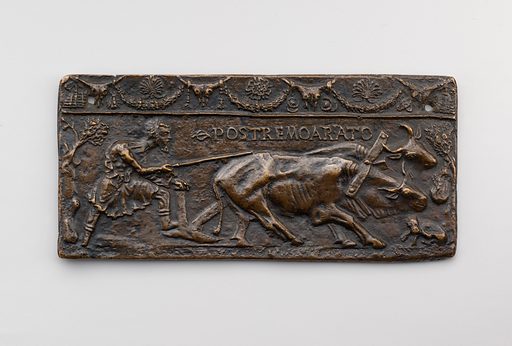
In 458 BCE, facing military attack from neighboring tribes, the Roman Senate took a drastic measure reserved for the direst of circumstances: they appointed a dictator to lead the state during this time of trouble. As Roman historian Livy tells it, Cincinnatus, the Senate-appointed dictator, left his farm and rushed to join the army, which he led to a swift and brilliant victory. Then Cincinnatus resigned his extraordinary powers and returned to his farm. For the remainder of the Roman Republic and well into the Imperial Period, Cincinnatus was seen as the quintessential Roman cultural hero and model of virtue: an aristocratic man and a talented soldier, general, and politician who put the interests of Rome above his own.
Later, a different sort of cultural hero emerged. In 203 CE, a young noblewoman and her slave were executed in Carthage, thrown into the arena with the lions, punished for their stubborn devotion to the Christian faith. The two women, Perpetua and Felicity, gave up a life of relative comfort to be true to their religious beliefs. Stories of martyrs abounded during the Later Roman Empire, perpetuating their status as new cultural heroes. The story of the Roman world from the foundation of the city of Rome to the fall of the Roman Empire in the West is a tale of transformations in geographic reach as well as dramatic changes in cultural values and beliefs. It is the remarkable tale of how a small village on the Tiber grew to become one of the largest empires in world history. Following the collapse of part of that Empire, Europe arose from its ashes, testament to its critical impact on world history.
EARLY ROMAN DEVELOPMENTS
Geographic Influences
Rome’s history is often divided into two major periods: the Republic from the late 6th century BCE to the late 1st century BCE, and the Empire from the late 1st century BCE to the fall of the Western half of the empire in the late 5th century CE. As early as the late 1st century CE, the Romans thought of their history in terms of those two periods, as seen in the writings of the Roman historian Tacitus. During its early centuries, Rome was ruled by a Republican government which distributed power, in theory, among all Roman citizens. In practice, it was really an aristocratic oligarchy. Under the later Empire, Rome was under one ruler, the Emperor (Caesar). Recent research has challenged the over-simplification of Roman history implied by this characterization of just two periods. A vast, sprawling story of a society that held sway over the Mediterranean world and Europe for centuries necessarily encompasses many complexities.
Roman history is the story of Rome’s transformation “from village to empire” (Boatright 2011). The geography and topography of Rome, Italy, and the Mediterranean world played a key role in expansion of the empire but also created challenges which shaped their history. Before it was capital of a major empire, Rome was a village built on seven hills sprawling around the river Tiber. Set sixteen miles inland, the original settlement was immune to attacks from the sea, and the seven hills on which the city was built were easy to fortify. The Etruscans dominated much of northern Italy, while the southern half of Italy was so heavily colonized by the Greeks that it earned the nickname “Magna Graecia”, meaning “Great Greece.” In addition, several smaller tribes shared the peninsula with early Romans, including the Latins, the Aequi, and the Sabines. Despite threats from neighbors, Rome was never absorbed by them. The Alps and the Apennines provided natural defenses in the north, hampering invasions from the outside.
Italy also boasted fertile farmlands that contributed to Rome’s early stability and success. The Tiber, though marshy and prone to flooding, fostered trade with neighboring city-states. During the Republic era, the Romans built a harbor at Ostia, expanding Rome’s access to the sea. Ostia grew to become a full-fledged commercial arm of Rome; carts from Ostia poured into Rome delivering food and other goods from all over Italy and the Empire. The city of Rome, center of the empire, reached a population of one million by 100 CE. Population growth, in addition to environmental pressures and declining crop yields, made feeding the city of Rome a challenge that required exploiting the resources of colonized areas. Egypt in particular became known as the breadbasket of Rome.
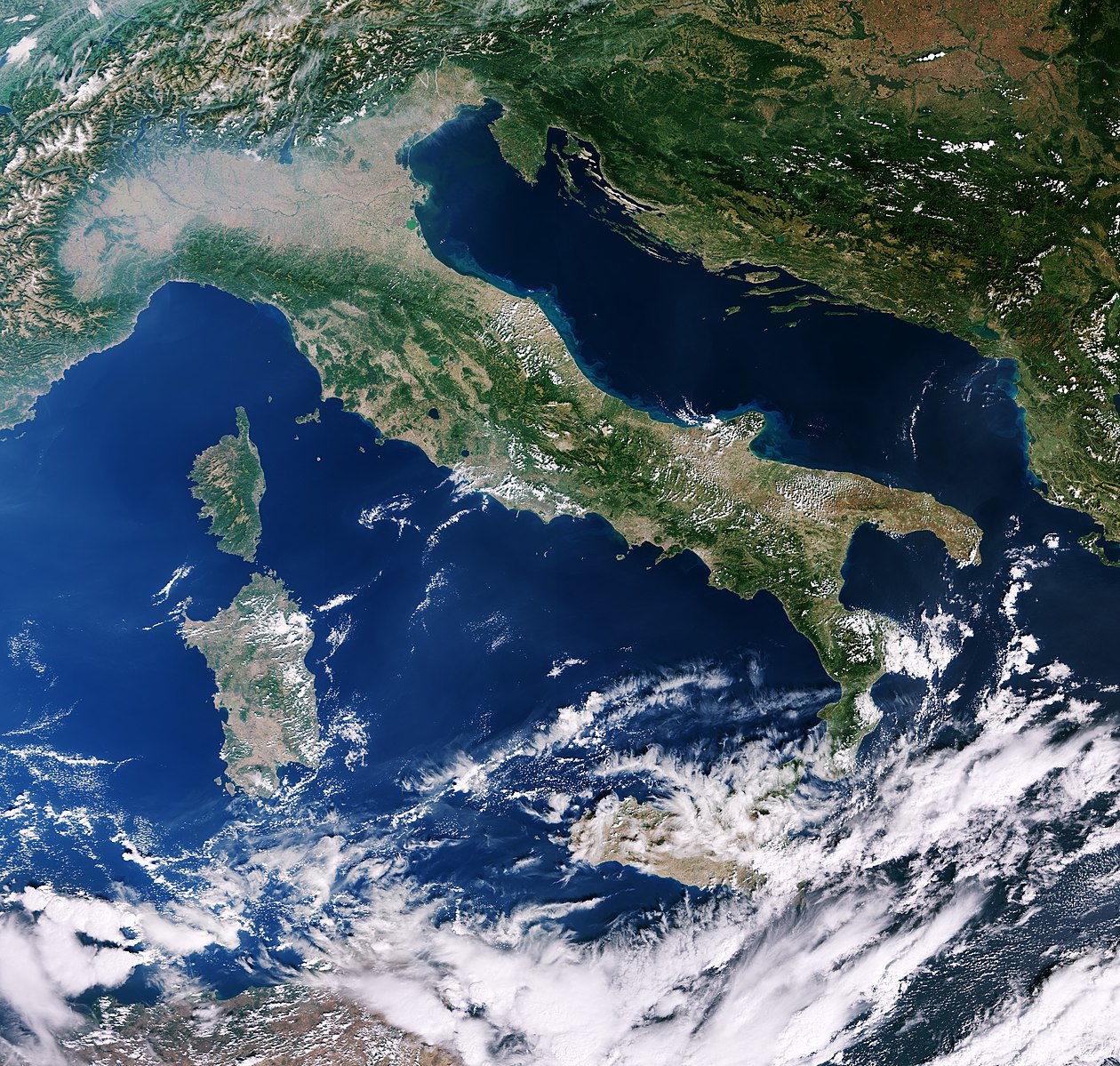
Historical Sources
One of the greatest challenges to modern historians is the seeming lack of interest by Romans in writing their own history for their first 600 years. According to Roman legend, Rome was founded in 753 BCE, yet the first Roman history in Latin, Origins, composed by the Republican politician Cato the Elder, was not published until 149 BCE. A few senators wrote about Roman history in Greek earlier on, and some aristocrats kept family histories, but Cato’s work was the first to address Roman history on a large scale, narrating events from the foundation of the city to Cato’s own death. Only fragments of Cato’s history survive and they indicate Cato’s approach to writing history was rather unusual. Instead of referring to individuals by name, Cato referred to them by title or political position. As a result, his history was truly focused on glorifying the accomplishments of Rome rather than individual Romans. Thankfully for modern historians, Cato’s experiment of nameless history did not catch on with subsequent Roman historians. Historians today are able to reconstruct the story of the Romans from a variety of written and archaeological sources, though some sources present problems, leaving historians to reconstruct a picture of Rome and Romans based on limited evidence available.
Few histories survive from the Republic period. The most famous and voluminous is by Livy, who wrote his Ab Urbe Condita (From the Foundation of the City) in the late 1st century BCE. Other prominent historians of the Republic whose works survived include Sallust, who turned to writing moralistic history after a frustrating political career. Julius Caesar wrote two books about his own campaigns: The Gallic Wars, about his conquest of Gaul in the 50s BCE, and The Civil War about his war against Pompey in 49 – 45 BCE. In the early 2nd century CE, Tacitus, another politician turned historian, wrote two works about the history of the Roman Empire during its first century of existence. The Annals covered the rule of emperors Tiberius through Nero, while The Histories continued the narrative to the rule of the emperor Domitian. Ammianus Marcellinus, a military officer writing in the late 4th century CE, composed a massive history of the Roman Empire from the end of Tacitus’ work to his own day. The biographer Suetonius, a contemporary of Tacitus, composed tabloid-style biographies of the first twelve emperors, from Caesar to Domitian. The anonymous Historia Augusta, composed sometime in the late Empire, provides similarly sensationalizing biographies of Roman emperors and usurpers from the emperor Hadrian in the early 2nd century CE to Carinus in the late 3rd century CE. In addition to these Roman historians and biographers, a number of historical works in Greek survive from the late Republic and the Empire. The Greek biographer Plutarch, writing in the 1st century CE, paired biographies of famous Greeks and Romans, for example comparing the lives of Alexander the Great and Julius Caesar. Josephus, a Jewish rebel leader turned Roman citizen, wrote The Wars of the Jews, a detailed account of the disastrous Jewish revolt against Rome in the 60s CE.
Works of history are only one source modern historians use. Other written sources include poems, novels, letters of politicians and other prominent figures, military and farming manuals, and even cookbooks. One of the best sources for the political ideology of the Augustan age, for example, is Virgil’s epic poem The Aeneid, a literary source which tells the story of the Trojan hero Aeneas and his struggle after the fall of Troy to reach Italy where he founded Rome. A useful source on everyday life in the Roman provinces under the Empire is Apuleius’ novel Metamorphoses, better known under the title “Golden Ass.” The novel is a fictional account of a man accidentally turned into a donkey who tells the narrative of his travels through the Roman Empire in the late 2nd century CE. A valuable source for understanding how Roman provinces were governed is the correspondence of Pliny the Younger, governor of the province of Bithynia on the shores of the Black Sea in 111 – 113 CE. Based on these letters, the job of the provincial governor certainly appears to have been decidedly unglamorous.
Early Christianity is one area of Roman history that is well documented. The New Testament is a source containing interpretations of early Christians about their faith and its spread throughout the Roman Empire. A variety of popular heretical texts from the 2nd and 3rd centuries also survive, allowing historians to reconstruct dissenting views about the beliefs and history of early Christianity. Writings in Greek and Latin by influential figures in the early church, dubbed Church Fathers, document the theological debates that resulted in the Nicene Creed. Starting in the 2nd century CE, martyrdom accounts and saints’ lives provide semi-fictional and stylized biographies of individual believers. Two prominent theologians in the Late Empire attempted to write (or re-write) Roman history through a Christian lens. Eusebius, Bishop of Caesarea in the 4th century CE, wrote The History of the Church: From Christ to Constantine, a history of Christianity from its beginnings to his day. In the early 5th century CE Augustine, Bishop of Hippo in North Africa, wrote The City of God, a massive work covering the history and legends of Rome from its beginnings, emphasizing Rome’s successes were due not to the pagan gods but were a result of the Christian God’s mercy.
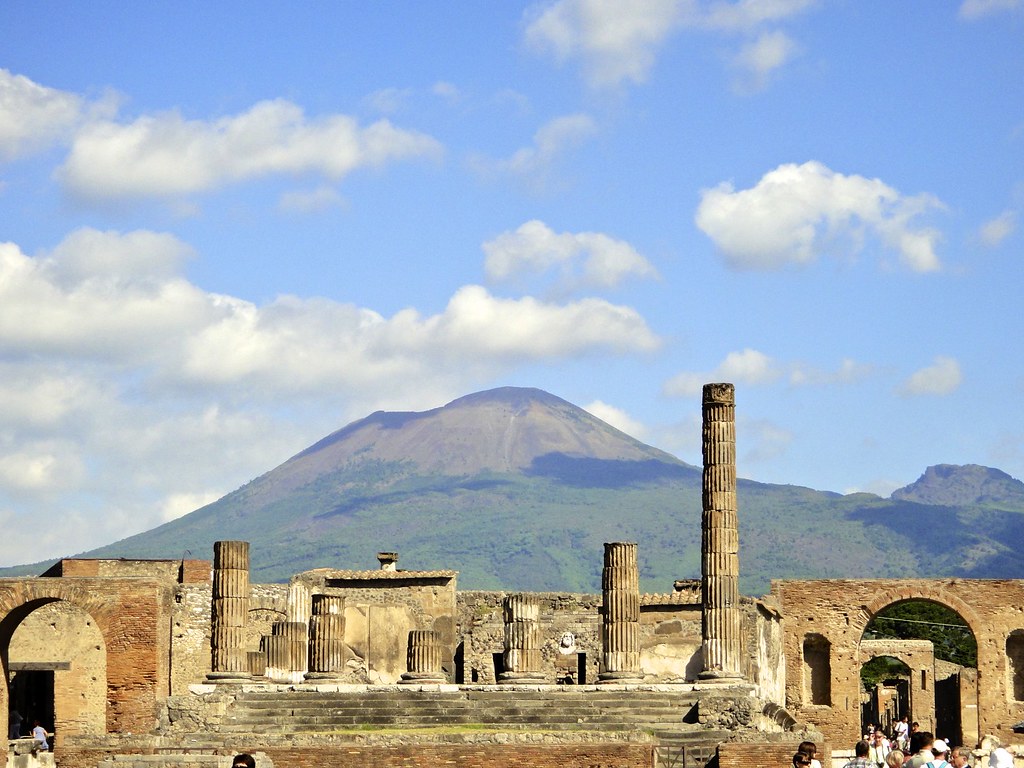
In addition to written documents, archaeological sources provide further insight into Roman life e.g. inscriptions on gravestones. Traded goods, such as lamps or bricks, allow historians to reconstruct the movement of goods across the empire. Several Roman towns and military camps provide valuable archeological evidence, for example the ancient site of Pompeii. The eruption of Vesuvius in 79 CE caused volcanic ash to rain down on the Roman resort town of Pompeii and nearby town of Herculaneum, effectively burying both towns and preserving them completely for modern archaeologists. The tragedy for Roman residents of these two towns proved to be a modern archaeologist’s dream.
Diverse sources survive from different periods of Roman history but certain perspectives are still difficult to reconstruct. Slaves in the Roman world were as archaeologically invisible as in the ancient Greek world. Likewise, very little evidence documents women’s lives before the rise of Christianity, and their voices are largely left out of Roman history. Other than epitaphs on their gravestones, most average Romans left little or no record of their lives, so evidence from the aristocracy dominates our historical understanding. Still, a careful historian can gain insight into lesser-documented perspectives by gathering and analyzing all relevant references in surviving sources.
EARLY AND MIDDLE REPUBLIC ERAS
Conflict of the Orders and Political Reforms
The period from the founding of Rome to the end of the Punic Wars is less documented than subsequent Roman history, yet during this formative time Rome grew from a village on the Tiber to a pan-Mediterranean empire. Polybius, the Greek politician-turned historian, spent seventeen years as a hostage in Rome and became an admirer of the Roman military and political machine. In the prologue to his Histories, in which he documented the meteoric conquest of the Mediterranean world by the Romans, he extols:
“Can any one be so indifferent or idle as not to care to know by what means, and under what kind of polity, almost the whole inhabited world was conquered and brought under the dominion of the single city of Rome, and that too within a period of not quite fifty-three years? B.C. 219-167. Or who again can be so completely absorbed in other subjects of contemplation or study, as to think any of them superior in importance to the accurate understanding of an event for which the past affords no precedent” (Polybius 1.1.6).
Polybius’ question pointed to a subsequently proposed answer: part of the reason for the Romans’ success was the adoption of the Republican government to replace their original monarchy. Polybius became increasingly convinced during his stay in Rome that Rome’s government was superior to all others in the Mediterranean at the time. The famed Republic system evolved over the course of centuries.
Roman society grew up as a loose alliance of several villages on the Tiber river. To minimize war against each other, these villages set up a common meeting ground where public discussion took place on neutral ground. Their first government ruling this a unified community was a monarchy, established around 753 BCE. By 509, a conservative revolution occurred when Roman business leaders, concerned with consolidation of power under the monarch, compelled the last Etruscan king, Tarquinius the Proud, to leave Rome. The gradual evolution of the government reflected the growing dissatisfaction of the lower socio-economic majority of the city excluded from political processes.
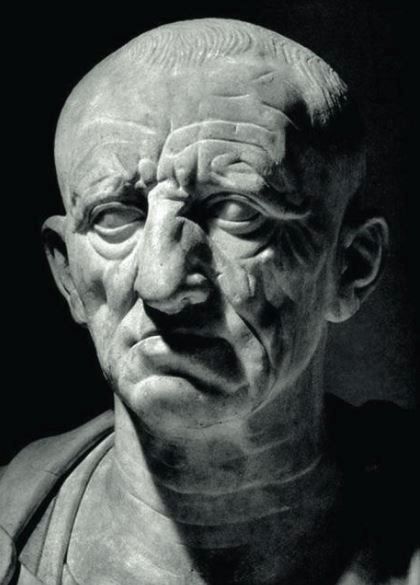
Roman sources indicate shared foundational values, for example a strong respect for the past. This reverence for the past was termed mos maiorum, “custom of ancestors” or “custom of elders”. Successful reformers such as the emperor Augustus presented reforms as a return to something old, rather than something new. Three additional values defining Roman society were auctoritas, “power” or “authority”; dignitas, roughly meaning “dignity;” and gravitas, “seriousness.” Augustus, Rome’s first emperor, later described his position in the state as having more auctoritas than anyone else. The other two qualities, dignitas and gravitas reflected one’s bearing and behavior as a true Roman. Jocularity was not valued; seriousness reflected distinctively Roman conduct and determination. Romans never smiled in portraits; the austere facial expression instead conveyed their power and superiority to those they conquered.
While sharing common values, Roman society exhibited influential social divisions. Roman citizens were divided into two orders. Patricians were defined as descendants from the first one hundred senators appointed to the Roman aristocratic Senate by king Romulus. Plebeians referred to all free citizens who were not patrician or a slave. The early Republic experienced an influential conflict between these two orders. Patricians established and sought to maintain a government that reserved all political power for themselves, while plebeians fought for inclusion and the opportunity to hold political and religious offices. Plebeians discovered in the early 5th century their most powerful weapons were secession and carrying out boycotts until the patricians acquiesced to a demand. Over several decades, plebeians slowly gained more rights and powers. While much about this Conflict of the Orders is shrouded in legend, it is possible to track its progress through the legislation passed.
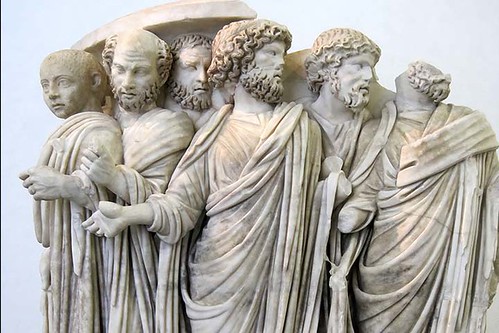
In 494 BCE, following the first plebeian secession, the Roman Senate allowed male plebeians to elect plebeian tribunes. Plebeians could elect officers to the Plebeian Council, an assembly of all plebeian citizens which advocated for plebeian interests. Plebeians also advocated for public display of the laws to protect the poor during lawsuits, leading to publication of the first public Roman legal code, the Twelve Tables, inscribed around 450 BCE. The highest political office in the Republic, consul, was reserved solely for patricians until 367 BCE, when a law was instituted requiring one of the two consuls elected each year to be plebeian. Phrasing of the law was significant as it allowed the possibility both consuls elected in a particular year could be plebeian, though this did not happen until 215 BCE. Modern historians consider the Lex Hortensia of 287 BCE as marking the successful end of the Republican Conflict of the Orders. This law made all legislation passed by the Plebeian Council binding on all Romans, patricians and plebeians alike. The Conflict of the Orders represented the gradual weakening of patricians and growing influence of plebeians in the Roman Republic. By the 3rd century, some plebeian families were as wealthy and successful as patrician families, while some established patrician families had fallen on hard times.
Learning in Action – The Roman Republic System
View image: “Chart of Roman Republic – Checks and Balances”, Ancient History Sourcebook 2000
Link: https://sourcebooks.fordham.edu/ancient/rome-balance.asp
Roman Religion
Roman religion was polytheistic, with many myths and gods aligned to Greek counterparts. Zeus, Greek king of the gods, became the Roman Jupiter under the title Jupiter Optimus Maximus, or Jupiter the Best and the Greatest. His consort, Hera, became the Roman goddess Juno and was the patron goddess of marriage. The Greek Athena became the Roman Minerva, the patron divinity of wisdom, justice and crafts. Both Venus (Greek: Aphrodite), goddess of love, and Mars (Greek: Ares), god of war, had mythical family connections to Rome’s human founders. Countless other divinities were worshiped; even the Roman sewer system, Cloaca Maxima, had its own patron goddess, Cloacina.
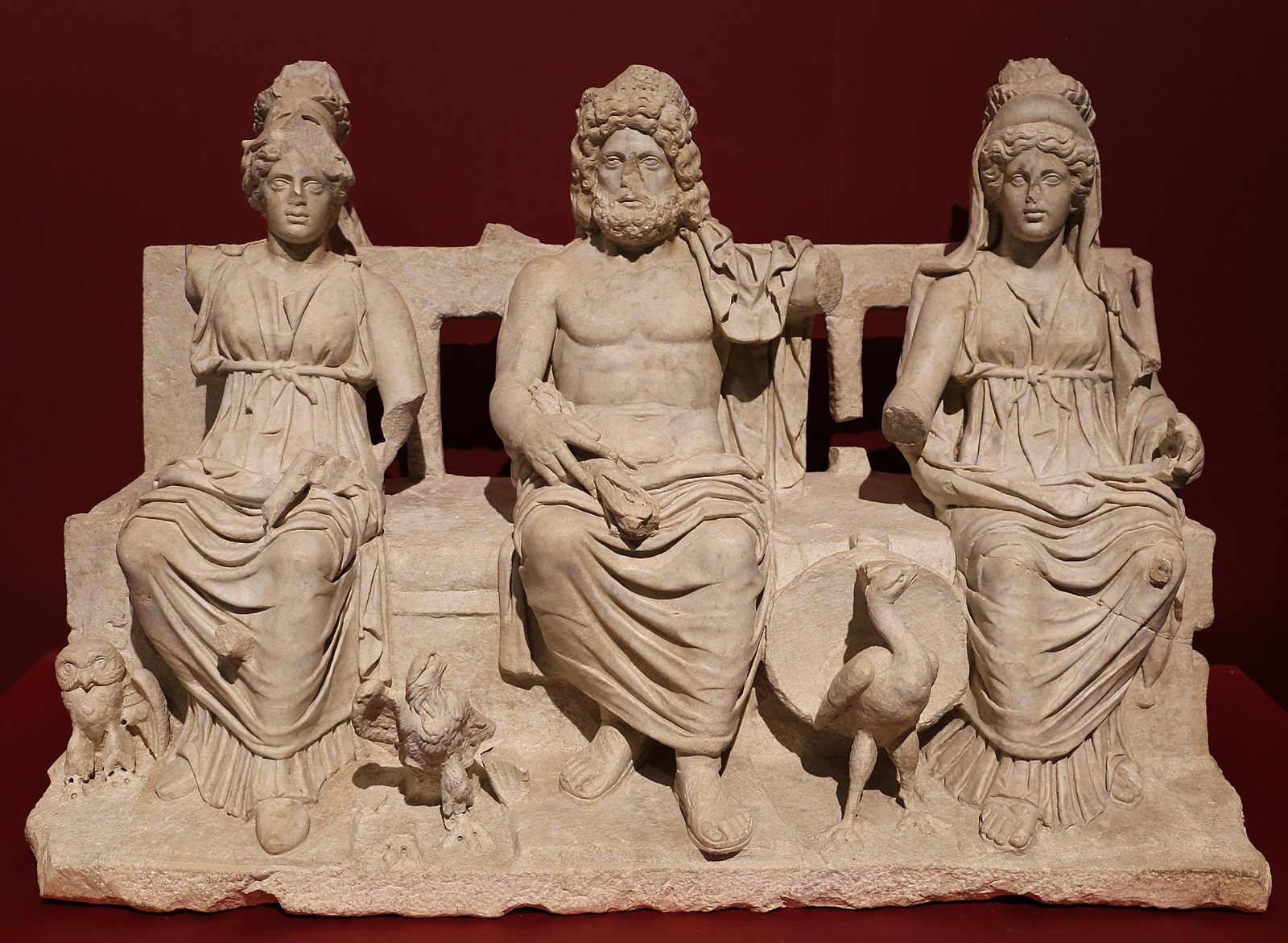
Romans worshiped some gods in private, making vows and promising gifts if the gods fulfilled a request, but Roman religion also had a significant public component under the authority of the priestly colleges. Although not limited to politicians, membership in these colleges was often key to political advancement. Julius Caesar’s political career, for example, took off after his appointment to the religious office of pontifex maximus, head of Roman religion. Ultimately, both public and private religious practices were aimed at the same goal: keeping the pax deorum, peace with the gods, upon which Romans believed the success of their state rested. As long as Romans maintained a respectful peace with their gods, these deities ensured Rome’s success. Whenever any disasters befell the state, Romans typically assumed pax deorum had been violated in some way. The gods must be appeased to end the disaster and prevent similar events from occurring in the future.
Roman Expansion
Early in Rome’s history, military actions were largely defensive, but shortly after 500 BCE Rome’s aggressive expansion began in earnest. Until the late Republic, Rome did not maintain a standing army. A new army was raised for each campaign, these were typically launched in the spring and ended in the fall. Similar to the Greeks, Romans had a minimum wealth requirements for military service since soldiers supplied their own equipment.
A significant pattern in early Republican military history was repeated conflicts with the same enemies, for example there were three Samnite Wars, three Punic Wars, and four Macedonian Wars. Roman expansion in the 490s BCE appears to have begun as a defensive measure. In either 499 BCE or 496 BCE, the expelled seventh king of Rome, Tarquin the Proud, joined forces with the Latin League (about thirty city-states around the city of Rome) and led them in an attack, resulting in the Battle of Lake Regillus – a decisive victory for Rome. The Romans signed an uneasy peace treaty with the Latins, but war broke out again in 340–338 BCE. Roman victory this time resulted in absorption of the Latin city-states into the Roman state, with some residents treated as partial citizens. The Romans also gradually conquered Etruscan city-states to the north.
While still fighting the Latins, the Romans embarked upon a series of three wars with neighbors to the east, the Samnites, the last of which ended in 290 BCE. Each of these wars resulted in Roman territorial gains and by the end of the Third Samnite War, Rome controlled all of central Italy. At some point during the Samnite Wars, the Romans apparently switched from fighting in the Greek hoplite phalanx fashion to a system of their own making, the manipular legion. The “maniple” form of battlefield maneuver was more flexible than the Greek phalanx while based on the same principle of foot soldiers operating together in close order drill for mutual support. The maniple was a smaller unit of organization that could be detached easily from larger groups and operate independently against the enemy. This new system allowed more flexibility in the arrangement of troops on the battlefield, as well as use of heavy and light infantry as needed, rather than keeping them in a static formation for the duration of a battle. The Roman army came to depend on speed, maneuverability and close mutual support to defeat its enemies.
The Romans spent 80 out of the 100 years in the 3rd century BCE at war. In 280 – 275 BCE, Rome became embroiled in a war with Pyrrhus, king of Epirus in northern Greece. The Romans fought three major battles against Pyrrhus, the first two of which he won at great cost to his army. Indeed, the term ‘Pyrrhic victory’ in modern English refers to a victory so costly as to actually be a loss. The Romans finally defeated Pyrrhus in their third battle against him in 275 BCE, demonstrating the superiority of the new Roman manipular legion against the phalanx of the Macedonians, the military descendants of Alexander the Great. This victory united all of Italy except for the very northern portion under Roman rule.
The genius of the Roman conquest was in not repeating the mistakes made by the Athenians with their empire. The Romans extended citizenship to residents of annexed towns as well as those from dependent cities who moved into Rome or married a Roman citizen. Men who became Roman citizens could participate in elections, stand for government office, join the Senate or the Plebeian Assembly, and enjoy the benefits of a massive trade network. Rather than treating those absorbed – Latins, Greeks, Sabines and others – as second-class subjects, Rome’s leaders extended varying degrees of citizenship to those living in these regions, including these new subjects, as part of an expanding Roman state. This inclusiveness created stable rule over what were dominantly loyal citizens. Rome could then recruit soldiers from Italian provinces made up of newly absorbed citizens. Recruiting from all of conquered unified Italy enabled a far larger military force of committed soldiers.
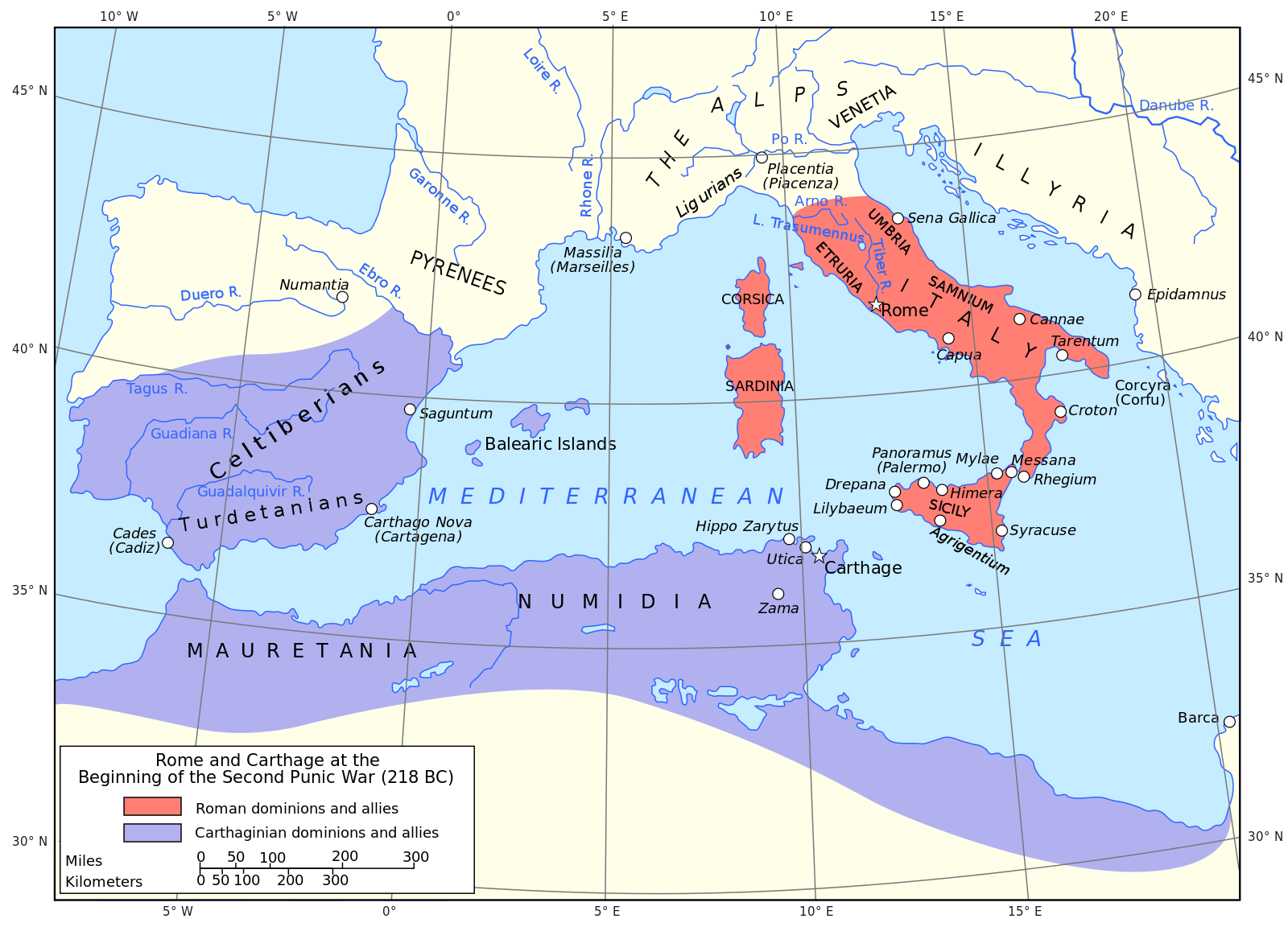
Between 214 and 148 BCE, Rome fought four separate Macedonian Wars. During roughly the same period, from 264 and 146 BCE, the Romans also fought three Punic Wars against Carthage, originally a Phoenician colony that had become a leading maritime power in the Mediterranean. During the Second Punic War (218-201 BCE), the Carthaginians, led by famed commander Hannibal, launched a surprise invasion from the north and for years dominated the Italian peninsula. But in the end, the ability of Rome to shift the fighting to North Africa led to Scipio Africanus the Elder’s victory at the Battle of Zama (202 BCE), eliminating Rome’s greatest foe. Roman final destruction of Carthage in the Third Punic War, and of Corinth in 146 BCE, allowed the Romans to gain full control over these societies and their land holdings, effectively putting the entire Mediterranean world under Roman rule.
In 146 BCE, as the Romans found themselves in control of a Mediterranean empire, they foresaw troubling consequences of such rapid expansion for the internal stability of Rome. A critical question faced them: how would the Republic, a system of government designed for a small city-state, adapt to ruling a large empire? The preliminary answer was to divide conquered territories into provinces with senatorial governors assigned to administer for terms from one to five years. Newly available governor positions made political competition in the Republic more intense. Senators competed for the most desirable positions, typically provinces in which military action was on-going since this meant the potential to win military glory and/or acquire some of that province’s wealth while governing. More complex political problems associated with Rome’s expansion to empire also became apparent.
Reading the Past – Hannibal of Carthage
Read: “Excerpt from Cornelius Nepos (c.99-c.24 BCE): Hannibal”, from Cornelius Nepos: Hannibal, trans. J. Thomas, 1995
Link: http://web.archive.org/web/20040803204542/http://129.186.40.170/THOMAS/netscape/hannibal.htm
FALL OF THE ROMAN REPUBLIC
The Gracchi and the Beginning of Political Violence
Victory over Carthage in the Second Punic War allowed Rome to dominate the Mediterranean by acquiring control over all territories that belonged to Carthage. Destruction of Carthage in the Third Punic War finished off any hope of a Carthaginian recovery, further cementing Rome’s control over the entire Mediterranean. The Roman historian Sallust, however, grimly predicted Roman victory in the Punic Wars was the beginning of the end of the Republic. Sallust and some other conservative politicians of his day believed this victory corrupted the noble Roman character, traditionally steeled by privation. The abundance of resources that flowed in following victories over Carthage also raised the divisive issue of distribution of new wealth and land. Disagreements over wealth distribution dominated the politics of the Late Republic, creating two new political factions: the Populares, those who protected the interests of the people, and the Optimates, those who protected the interests of the elite element of the populace.
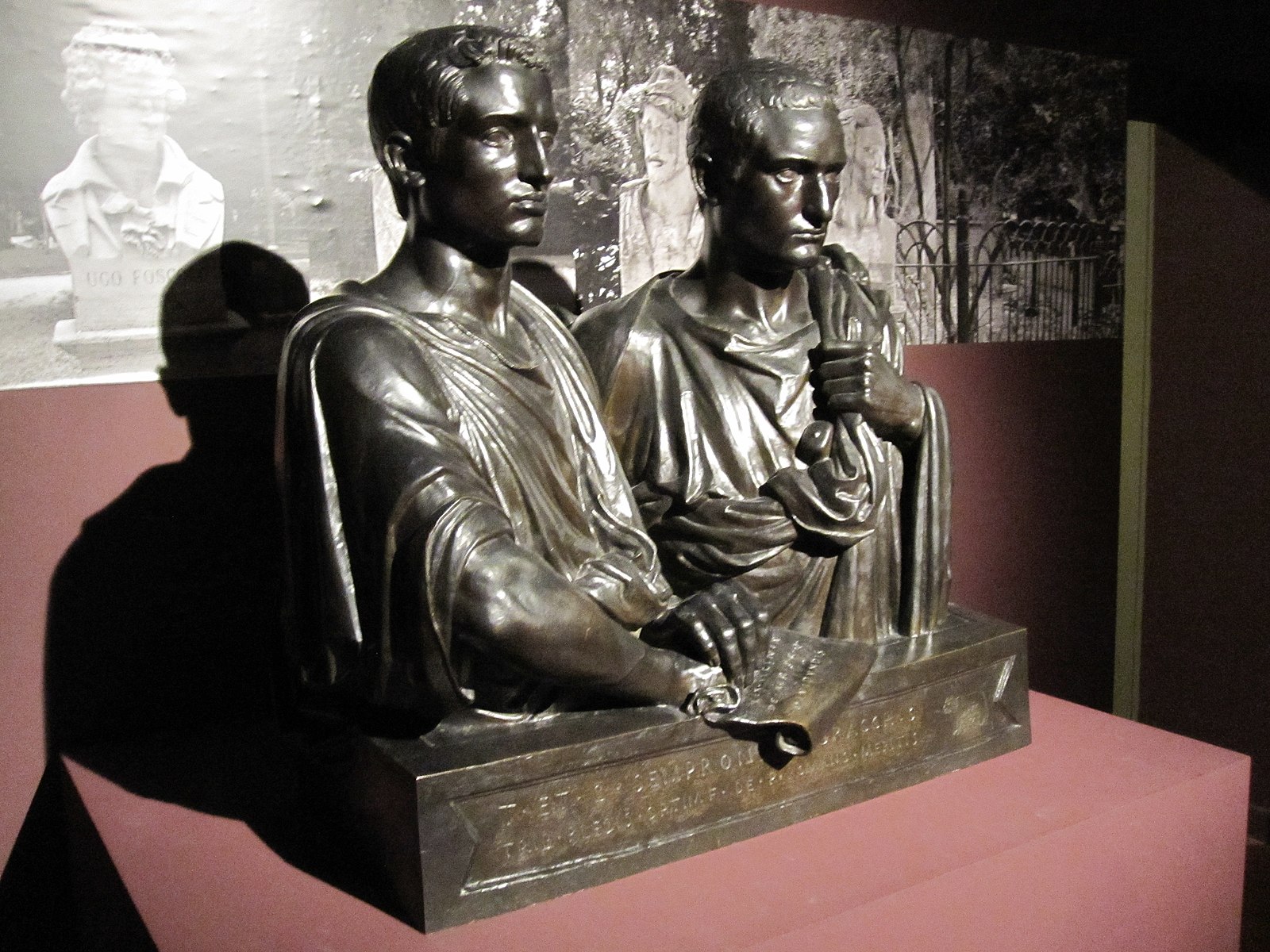
The Roman Republic had experienced minimal political violence up to 133 BCE. The 2nd century BCE, however, was wracked by political violence and civil wars, exemplified by the experiences of the Gracchi brothers. In 133 BCE, Tiberius Sempronius Gracchus, a scion of one of the oldest and most respected families in Rome, was one of the ten annually elected plebeian tribunes. Alarmed that lands acquired through recent Roman conquests were dominantly taken over by rich landowners, Gracchus proposed a land distribution law known as the Lex Sempronia Agraria. Gracchus argued land redistribution would benefit the state since land-ownership was a prerequisite for military service. Gracchus took his law directly to the Plebeian Council, where it passed, resulting in escalating conflict between Gracchus and the Senate. At a meeting of the Senate, the pontifex maximus, Tiberius Gracchus’ own cousin Publius Cornelius Scipio Nasica, argued Gracchus had attempted to make himself king and had to be stopped. Since weapons were banned inside the Senate building, enraged Senators grabbed whatever was on hand, including chair and table legs, and clubbed Gracchus to death in a shocking display of political violence. This was the first instance of this kind of civic strife in ancient Rome.
The death of Tiberius Gracchus also meant the death of his proposed law. Ten years later, Gracchus’ proposed reforms were championed by his younger brother, Gaius Gracchus, who was elected plebeian tribune in 123 BCE and served a second term in 122 BCE. Gaius Gracchus’ revived agrarian reform proposal was even more ambitious than his brother’s a decade earlier. Especially controversial was Gaius Gracchus’ proposal to grant full Roman citizenship to Rome’s Italian allies. In 121 BCE, alarmed by Gaius Gracchus’ popularity with the people, the consul Lucius Opimius proposed a new measure in the Senate: a senatus consultum ultimum, or final decree of the Senate, which amounted to allowing the consuls to do whatever was necessary to safeguard the state. Realizing the passing of this law amounted to his death sentence, Gaius Gracchus committed suicide.
The proposed laws of the Gracchi highlighted the growing conflict between the rich and the poor in the Roman state, as well as the willingness of prominent Senators to resort to violence to resolve matters. This set a dangerous precedent, fundamentally changing the nature of Roman politics. The causes the Gracchi adopted did not go away. Rome’s Italian allies went to war against Rome in 90–88 BCE in the ‘Social War’, after “socii,” meaning “allies”. The result of this conflict was the granting of full Roman citizenship rights to Italian residents.
Civil Wars
The experiences of the Gracchi in the late Republic era were the first clear instances of Populares and Optimates in violent conflict. Later, a conflict between two politicians representing different sides in this debate resulted in a full-fledged civil war. In 107 BCE, impatient over the prolonged and challenging war against the Numidian king Jugurtha, the Romans elected Gaius Marius as consul. While Marius had enjoyed a distinguished military career, he was a novus homo or “new man,” a term used to refer to newcomers to Roman politics. Marius benefited from frustrations in Rome over the length of the war as well as perceived corruption of aristocratic leaders abroad. Once elected, he took command of the war as well as passed the most comprehensive reforms to the Roman military since the Romans switched to the manipular legion. Marius abolished the property requirement for military service, allowing landless Romans to serve in the army for the first time in Roman history. He instituted a new commitment on the part of the Roman state to arm troops and to pay them for service. The military became a profession rather than a seasonal occupation for farmers. Marius also changed the tactics of the legionary organization on the battlefield from the legion of maniples into one of cohorts.
Marius’ reforms, though controversial, proved immensely successful, and he swiftly defeated Jugurtha, ending the war in 104 BCE. Marius gained unprecedented popularity in Rome and was elected to five more successive consulships in 104 – 100 BCE, despite a law requiring ten years between successive consulships. While Marius began his military career fighting for Rome, however, he ended it by causing the worst civil war Rome had experienced to that point.
In 88 BCE, the Roman Senate was facing a war against Mithridates, king of Pontus. Sensing Marius was too old to undertake the war, the Senate instead appointed Lucius Cornelius Sulla. Summoning the Plebeian Council, Marius overturned the decision of the Senate and drove Sulla out of Rome. Instead of going into exile, Sulla gathered an army and marched on Rome – the first time a Roman general had led a Roman army against the city of Rome. Sulla took over Rome, swiftly had himself declared commander of the war on Mithridates, and departed for the Black Sea. In 86 BCE, Marius was elected consul for the seventh and final time, then promptly died of natural causes seventeen days after taking office. The civil war he started with Sulla, though, was still far from over.
In 83 BCE, victorious over Mithridates but facing a hostile reception from the Senate, Sulla marched on Rome for the second time. This time, he truly meant business. Declaring himself dictator to reform the Roman constitution, Sulla ruled Rome for the next three years. His reforms aimed to prevent the rise of another Marius, significantly curtailing the powers of the plebeian tribunes. In addition, he established the proscriptions — a list of enemies of the state whom anyone could kill on sight and whose property was confiscated. After enacting these reforms, Sulla resigned from politics, retiring to a family estate outside of Rome in 79 BCE where he appears to have drunk himself into an early grave. Most historians agree the Republican constitution never recovered from these destructive developments.
The civil war of Marius and Sulla reflected increased competition between officials in the Republic. It also demonstrated a dangerous side effect of Marius’ military reforms. Before Marius, Roman farmer-soldiers did not feel a personal affinity for their generals but rather a loyalty to the Roman state. After Marius’ reforms, soldiers were paid by their generals and their loyalties were directed towards individual leaders as much as, or more than, the Roman state. In 63 BCE, Lucius Sergius Catilina, a patrician who unsuccessfully ran for consulship, banded with other frustrated Senators to assassinate the consuls and take over the state. Catilina’s conspiracy failed but Catilina’s plan to resort to violence to achieve power shows just how quickly political violence became the ‘normal’ solution to problems in Roman Republican politics after the violent treatment of the Gracchi.
The First Triumvirate
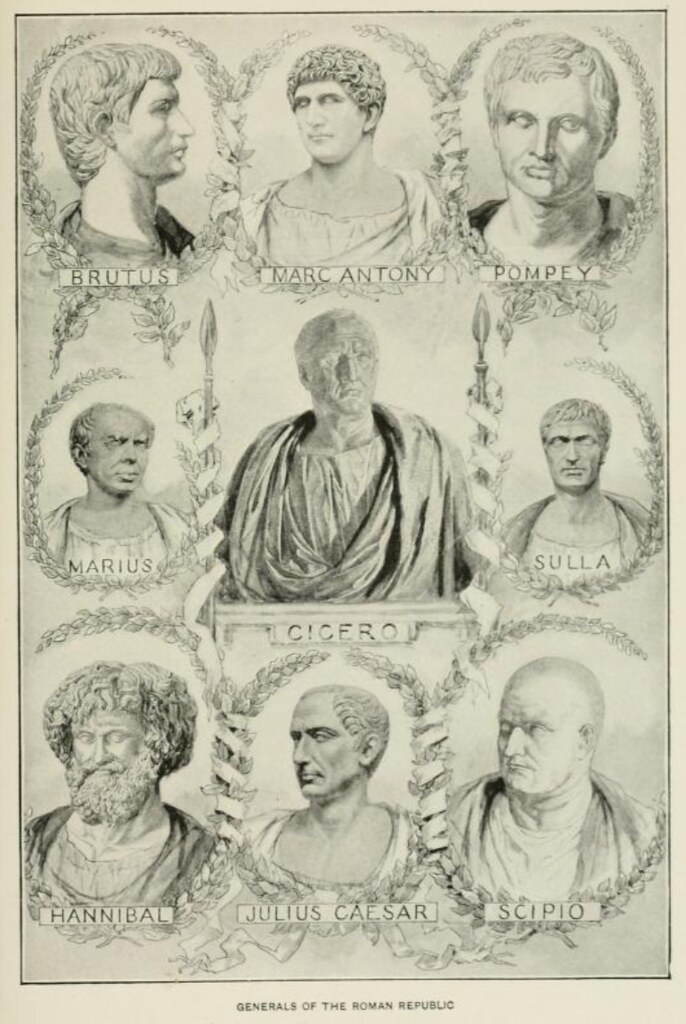
The political careers of Marius, Sulla and Catilina demonstrated the increased competition in the late Republic and ruthlessness with which some Roman politicians attempted to gain the consulship. In 60 BCE, three politicians formed an alliance that transcended the usual division of Populares and Optimates. Marcus Licinius Crassus was the wealthiest man in Rome, son of a consul and consul himself in 70 BCE. Gnaeus Pompey achieved military fame in his youth, earning him the nickname “Magnus,” or “the Great”. By 60 BCE, both Crassus and Pompey felt frustrated with their political careers and joined forces with a relative newcomer to politics, Gaius Julius Caesar. The three men formed an alliance, secret at first, which Cicero later dubbed the Triumvirate. Together, they lobbied to help each other rise to the consulship and achieve desirable military commands.
The alliance paid immediate dividends for Julius Caesar who was promptly elected consul for 59 BCE and awarded Gaul as his province for five years after the consulship. In 55 BCE, Crassus and Pompey were re-elected consuls and Caesar’s command in Gaul was renewed for another five years. Caesar published an account of his Gallic campaigns in installments during his time in Gaul; Romans were kept aware of Caesar’s successes and his popularity grew. His rising popularity was a source of frustration for the other two triumvirs. The already uneasy alliance disintegrated in 53 BCE. Crassus was killed at the Battle of Carrhae, fighting the Parthians, and Caesar and Pompey became official enemies.
Late in 50 BCE, the Senate, under Pompey’s leadership, informed Caesar his command had expired and demanded he surrender his army. Caesar refused to return to Rome as a private citizen, demanding to be allowed to stand for consulship in absentia. In 49 BCE, when his demands were refused, Caesar and his army crossed the Rubicon, a river which marked the border of his province. By leaving his province with his army against the wishes of the Senate, Caesar committed an act of treason as defined in Roman law; the civil war had begun.
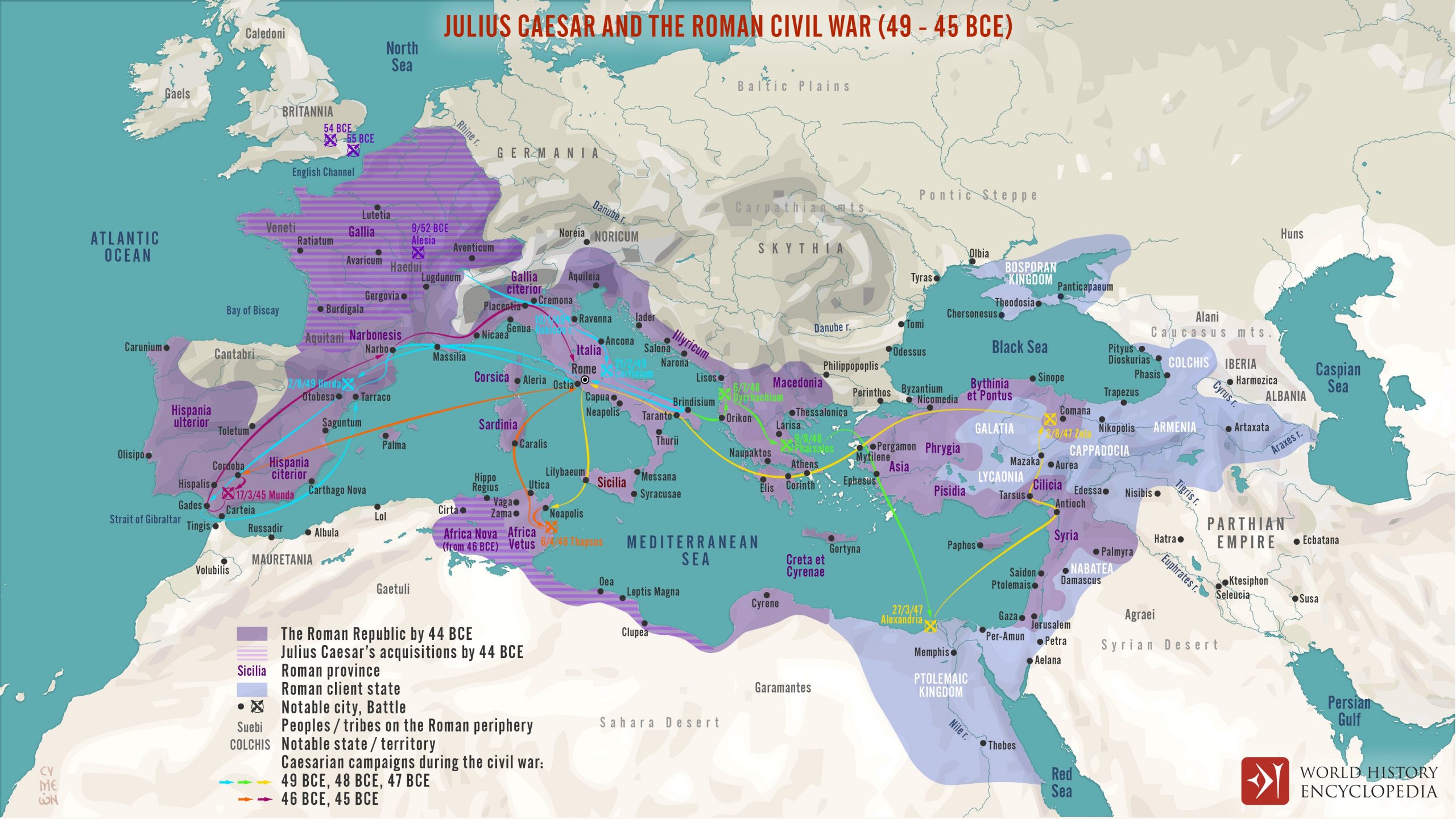
While most of the Senate was on Pompey’s side, Caesar started the war with a distinct advantage: his troops had just spent a larger part of a decade fighting with him in Gaul. Much of Pompey’s army, on the other hand, was disorganized. In 49 BCE, Pompey retreated to the south of Italy with Caesar in pursuit. In late 48 BCE, the two fought a decisive battle at Pharsalus in northern Greece where Caesar’s army defeated Pompey’s much larger forces. Pompey fled to Egypt where he was assassinated by order of Ptolemy XIII who hoped to win Caesar’s favor by this action. When Caesar arrived in Egypt in pursuit of Pompey, however, he sided with Ptolemy’s sister Cleopatra VII and appears to have fathered a son with her, Caesarion. With Pompey’s death, the civil war was largely over, though Caesar fought several battles across the Roman world with remnants of the senatorial army. While his military actions on behalf of Rome were largely limited to Gaul and a few forays into Britain, civil war against Pompey and his allies took Caesar all over the Roman world from 49 to 45 BCE.
The Age of Augustus
In February of 44 BCE, Julius Caesar took the title dictator perpetuo, or “dictator for life,” and had coins minted with his image and new title. His was the first instance in Roman history of a living individual placing his likeness on coinage. This new title appears to have been the final straw for about 60 senators who feared Caesar aimed to make himself a king. On the Ides of March (March 15th) of 44 BCE, the conspirators rushed Caesar during a Senate meeting and stabbed him to death. But if the conspirators thought that by assassinating Caesar they could restore the Republic, they were sorely mistaken.
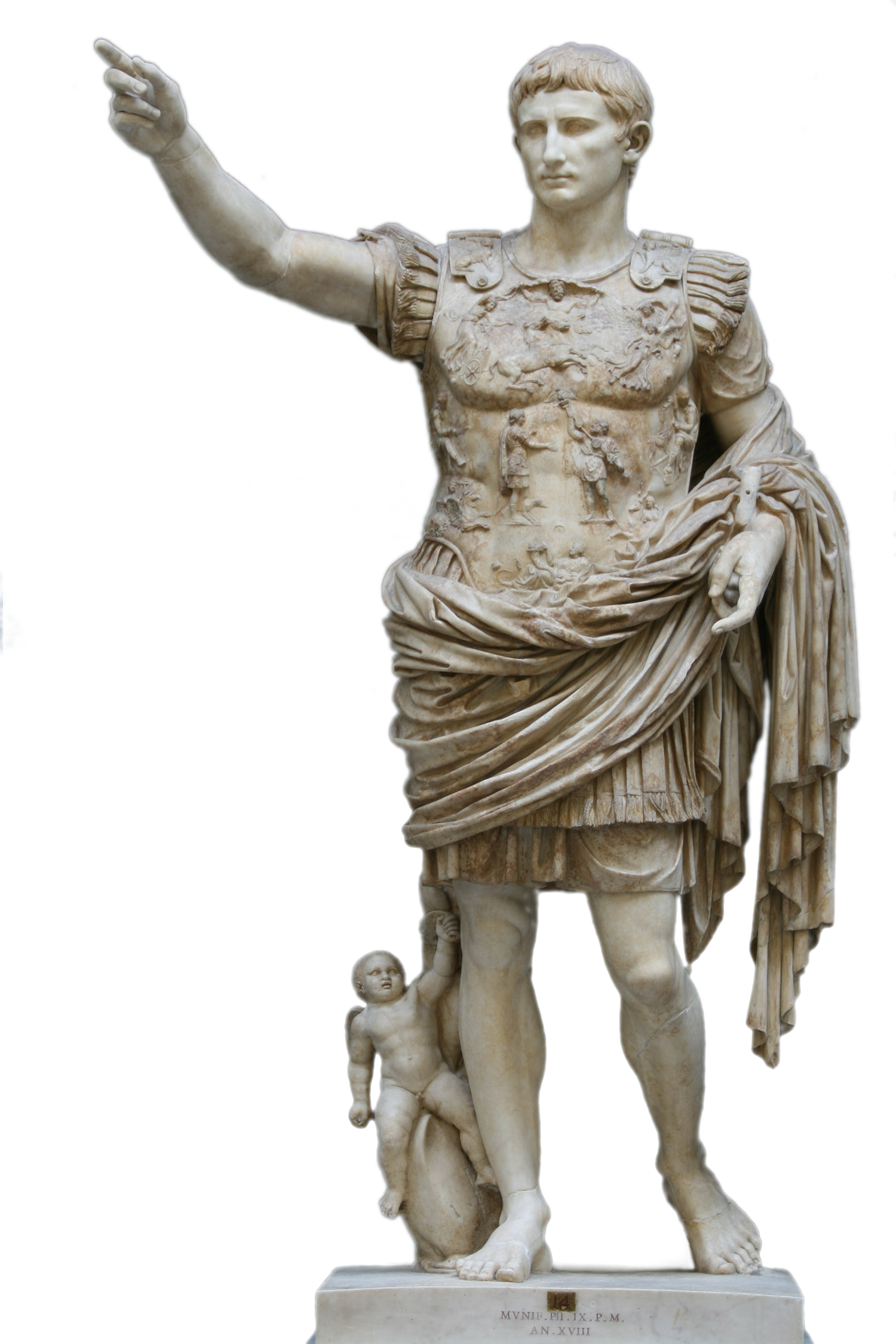
Caesar’s will left money to each resident of the city of Rome and donated his gardens for public use, further increasing his popularity among the people; popular rioting ensued throughout the city following his assassination. Since Caesar did not have legitimate sons, he had adopted an heir in his will, his grand-nephew Gaius Octavius, whose name after adoption became Gaius Julius Caesar Octavianus (Octavian in English). At the time of his adoption as Caesar’s heir, Octavian was 19 years old, too young to have had much military or political experience. He showed political acumen, however, by entering an alliance with two more experienced former allies of Caesar: Marcus Antonius (Marc Antony) and Marcus Aemilius Lepidus. Forming the Second Triumvirate, these three men aggressively pursued the enemies of Caesar and fought a small-scale civil war with Caesar’s assassins. The triumvirs defeated Caesar’s assassins at the Battle of Philippi in northern Greece in 42 BCE and divided the Roman world into regions ruled by each. Marcus Antonius claimed Egypt, though it was not yet a Roman province. He married Cleopatra and ruled Egypt with her over the following decade. Another civil war then erupted between Antonius and Octavian. Octivian’s decisive victory in the historic Battle of Actium in 31 BCE established his secure rule. Octavian, named Augustus in 27 BCE, ruled what was now the Roman Empire until his death in 14 CE.
Though modern historians refer to Augustus as the first emperor of Rome, that is not the title he used. Throughout his reign, Augustus claimed to have restored the Roman Republic; with the exception of a few elected offices, he did not have any official position. How then did he rule the Roman Empire for over forty years? Some answers are found in the Res Gestae Divi Augusti, an autobiography Augustus composed in the year before he died. In this document, Augustus described himself as the first citizen, or princeps, of the Roman state, superior to others in his auctoritas. He was especially proud of the title of “Pater Patriae,” or “Father of the Fatherland,” voted to him by the Senate, reflecting his status as patron of all citizens. Having learned from Caesar’s example, he avoided accepting any titles that might have smacked of a desire for kingship. Instead, he created for himself new titles and powers grounded in previous, Republican tradition. In addition, he proved to be a master diplomat, sharing power with the Senate in a way beneficial to himself, melding the Republican political structure with what was effectively one-man rule.
The question remains: when did the Roman Republic political system actually end? Different historians propose several possible answers. One position is the Republic fell with the dictatorship of Sulla, since this regime fundamentally altered the nature of the Republican government and permanently destabilized it. Another possible answer is the assassination of Caesar in 44 BCE. Others point to 27 BCE, when the Senate granted Octavian the title of Augustus in recognition of his consolidation of power. Yet another possible date is the death of Augustus in 14 CE. All of these events reflected the instability of the Roman state in the late 1st century BCE.
Environment in History – Rome’s Environmental Challenges
In addition to complex social and political challenges, degradation of the environment played a part in the collapse of the Republic. Degraded land meant eroded soil, reduced crop production and diminished living standards for the agricultural classes. A growing mass of landless poor, angry at reduced circumstances, flooded Rome and other cities, fueling political instability and paving the way for the Republic’s decline. Italy’s growing population had enabled greater military and economic power, fostering imperial expansion and creation of a vast trading network extending from Britain to North Africa to Mesopotamia. But feeding this population, as well as supplying expanding trade routes, placed destructive pressures on the land, including increased cultivation of fragile, marginal regions. Deforestation also accelerated; advanced iron tools intensified felling of trees and more wood fuel was needed to process that iron.
Romans, sophisticated in many areas of engineering and problem solving, did recognize the dangers of soil degradation and adopted some strategies to extend the life of the land, for example implementing multi-crop rotation, growing the best crops for diverse soils and employing ‘state of the art’ uses of fertilizers. But damaging effects from ongoing deforestation and plowing fragile areas still led to sedimentation of waterways. Silt runoff altered the course of rivers and impacted water transport access to the sea. Soil erosion followed the plow, as did depletion of nutrients. Soil degradation led to lower crop yields and by the early 1st millennium, some farmers were abandoning their fields. Destitute peasants fled to the cities, and in later years rulers tried to forbid movement from fields to the cities to ensure an agricultural workforce.
In the latter years of the empire, the once productive Italian peninsula could no longer feed Roman cities and Rome became dependent on imported grain from North African regions, in particular Egypt. Roman conquerors also emphasized intensive cultivation in conquered regions. Pressures on colonized regions to produce grain for Roman needs, in particular in North Africa and ancient Near Eastern regions, then accelerated soil erosion in these regions. Even after Rome’s fall, many of these regions remained impoverished as reliance on grazing animals prevented recovery of forests and soil cover, resulting in continual erosion.
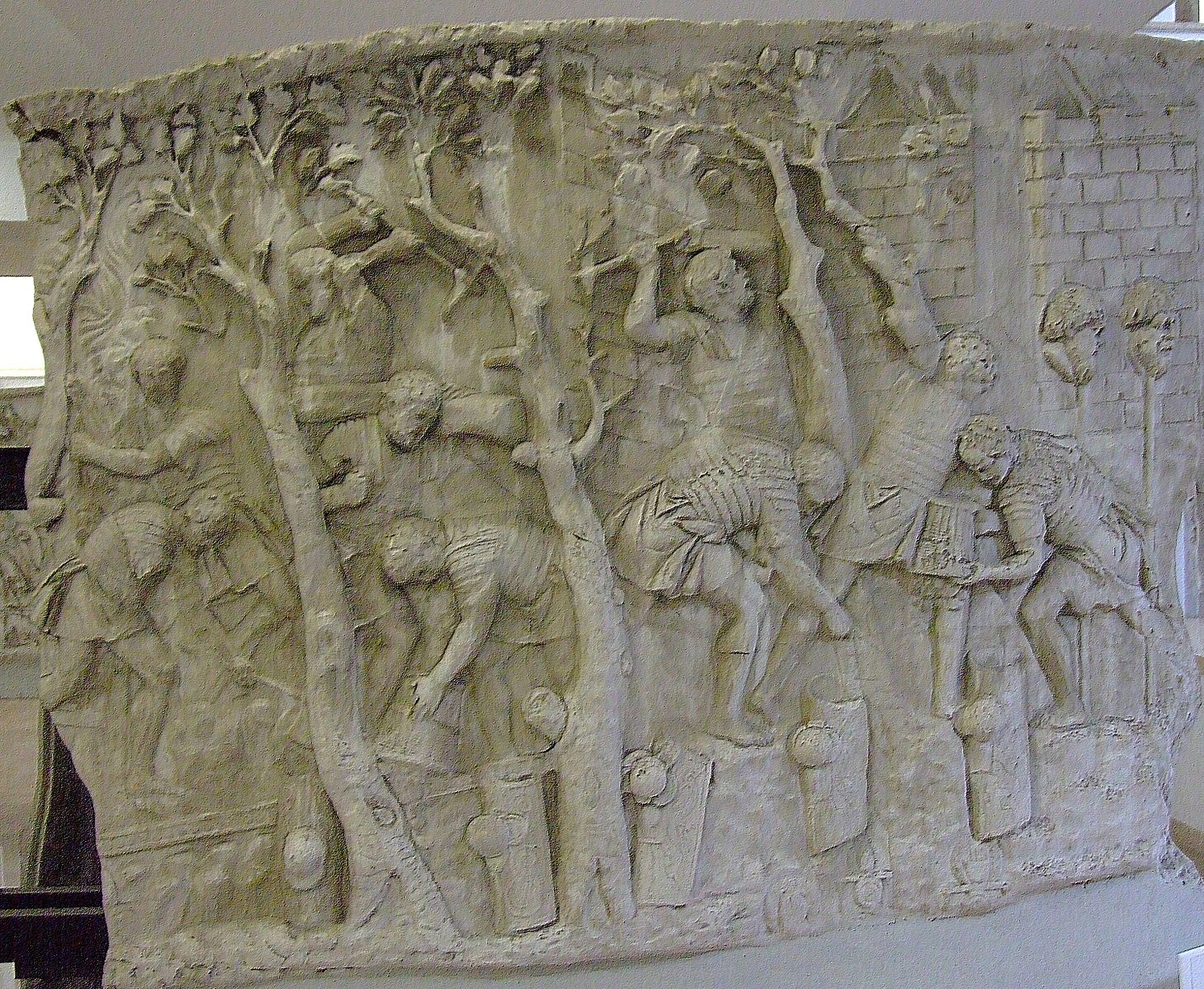
Romans at home and across the empire carried out destructive deforestation. As small villages grew to great towns and cities, timber needs could not be met by traditional, small-scale foraging and collection of forest debris. Trees were cut down in massive numbers to supply wood for heating, cooking, to heat Roman baths, and for cremation fires. Timber was also used to fuel production of bronze and iron, glass, tiles, ceramics, and products such as plows and carts. As one historian emphasized “(f)orests provided the major material for construction and almost the only fuel source of the classical world, and depletion of this source precipitated a number of crises” (Hughes and Thirgood 1982 60). These crises included rising prices for fuel, inflationary pressures on products, and soil erosion. The Italian climate is semi-arid, preventing rapid regeneration of trees, thus robust forests felled were replaced by sparse, scattered pockets of woodlands.
Trees were also needed to supply military and commercial ship building; stands of tall, straight timber for ship masts and construction were particularly valued, and therefore decimated. Romans again turned to their colonies to supply their resource needs, contributing to intensified deforestation in regions such as Syria and ancient Phoenicia. The Roman empire ultimately focused on exploiting timber resources of the ‘barbarian’ northern territories e.g. Central Europe.
Classical writings expressed concerns about depleted forests, pointing to consequences such as accelerating soil erosion. Yet despite early alarms, forests continued to be cut. Even when the problem was noted, the voracious appetites of cities and commerce dominated over calls for better resource management, a pattern seen throughout history. The decline of small farms and consolidation of lands into elite (patrician) owned latifundia to grow export crops intensified destructive pressures on the land. Resulting social anger undermined the Republic and contributed to the rise of repressive Imperial leadership, paving the way for the decline of the empire.
ROMAN CULTURE OF THE LATE REPUBLIC AND AUGUSTAN AGE
The late Republic was a period of growth for Roman literary arts as the age of Augustus saw a flourishing of Roman literature, due in large part to Augustus’ investment in sponsoring prominent poets to write about the greatness of Rome. The three most prominent poets of the Augustan age, Virgil, Horace, and Ovid, wrote glorifying Augustan Rome. Virgil’s epic The Aeneid, finished in 19 BCE, the Roman version of Homer’s Iliad and Odyssey combined, became the Roman national epic. It told of the travels of the Trojan prince Aeneas who, by will of the gods, became the founder of Rome. The age of Augustus was also a time of building and rebuilding around Rome. In his Res Gestae, Augustus includes a very long list of temples he had restored or built. Through these building projects, as well as the other arts Augustus sponsored, he intended to demonstrate his rule was a new Golden Age of Roman history, as peace was restored and Rome flourished.
Reading the Past – The City of Rome
Read: “Pliny the Elder (23/4-79 CE): The Grandeur of Rome, c. 75 CE from Natural History,” from Readings in Ancient History: Illustrative Extracts from the Sources, edited by William Stearns Davis, 1912-1913.
Link: https://sourcebooks.fordham.edu/ancient/pliny-natihist-rome.asp
Pax Romana
As the Republic died, replaced by rule of Emperors (Caesars), Roman armies continued to expand the empire’s borders. The massive territory encompassed by the empire required a sophisticated infrastructure of roads and sea routes, and the Romans provided both. By the 1st century CE, roads and routes connected the center of the empire (Rome) to the periphery, enabling armies, politicians, traders, tourists, and students to travel with greater security and speed than ever before. Roman engineers improved communications by building bridges and roads, while aqueducts increased agricultural production and economic growth in many occupied areas.
Primary sources make clear travel was never a safe undertaking, with bandits on roads and pirates on the seas. Greedy locals were always eager to fleece unsuspecting tourists, and ship-wrecks were an unfortunate common reality. Yet the Romans created an unprecedented network of transportation links that allowed travel throughout the vast empire for those who could afford the journey. In addition to multicultural exchanges, Roman control and building of infrastructure also resulted in the spread of Greco-Roman culture, including Roman influences in language, law and engineering abilities.
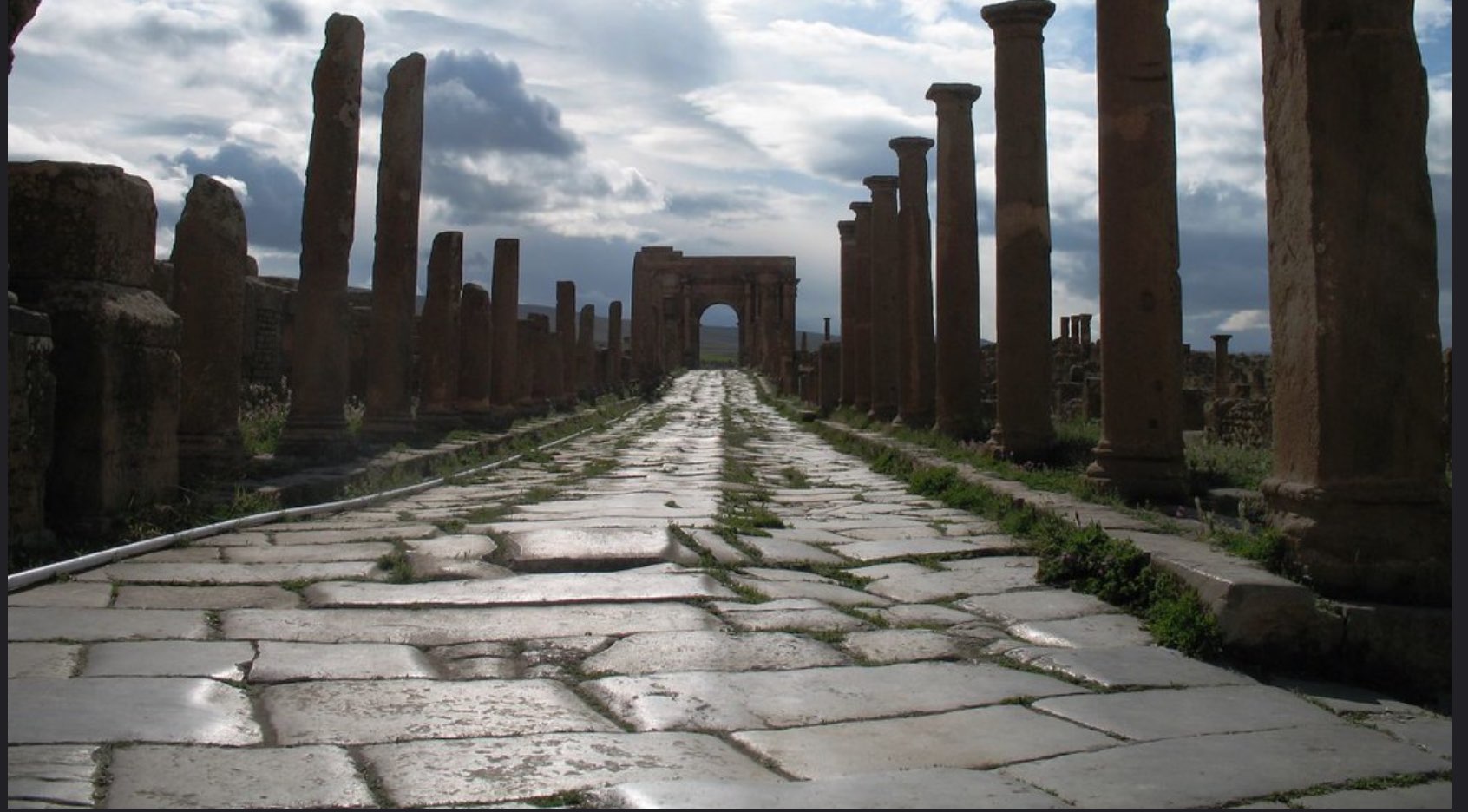
Learning in Action – Roman Technologies
Watch the video: “Top 8 Ancient Roman Technologies – History Countdown,” The History Channel 2021
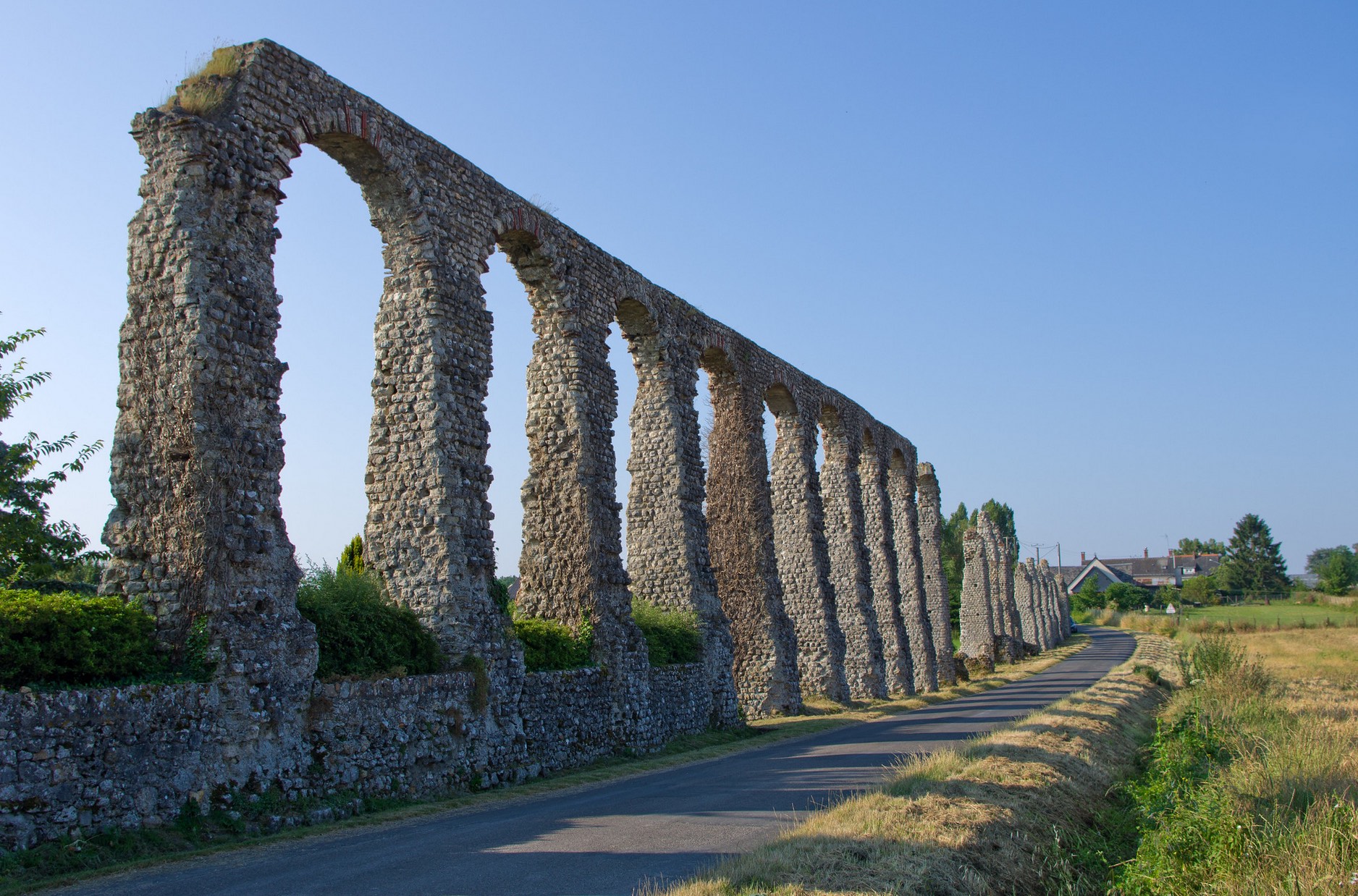
From 27 BCE when Augustus consolidated power, until the death of the emperor Marcus Aurelius in 180 CE, the empire enjoyed a period of relative peace and prosperity, an era referred to as the Pax Romana – the Roman peace. Territorial boundaries grew to their largest extent in the early 2nd century CE, while the Empire became a more smoothly run bureaucratic machine where commerce prospered. Still, some Roman subjects resented control despite the peace and greater commercial links forcibly imposed on them. Roman historian Tacitus narrated the speech of British tribal rebel leader Calgacus to his men before they fought and were defeated by the Romans in 85 CE: “Theft, slaughter, rapine they misname empire, they make a desert and call it peace” (Tacitus, 38). Other evidence from territories in the periphery of the Empire indicates Romanization was not absolute; some remote rural areas in provinces far from Italy did not fully feel the impact of the Empire.
One of the most significant long term legacies of this empire was the inclusion of Europe as a direct part of the Mediterranean world for the first time. Roman occupation of northern ‘barbarian’ territories resulted in long-standing garrisoned forces and army camps stationed throughout Europe. Many camps later grew to become important cities of Europe such as London and Paris. Retired Roman veterans colonized European territories, directly transplanting Greco-Roman and Hellenistic influences. Trade links extended between Mediterranean cultures and far Northern reaches of the empire. The Roman Empire built roads, bridges, gates and even amphitheaters throughout Europe. Many structures are still visible, some even still in use, in Europe as well as throughout the Mediterranean. It was also during this early empire period that a new religion, Christianity, arose. This religion did not have an immediate impact on the state, but its presence and growth led to fundamental changes centuries later.
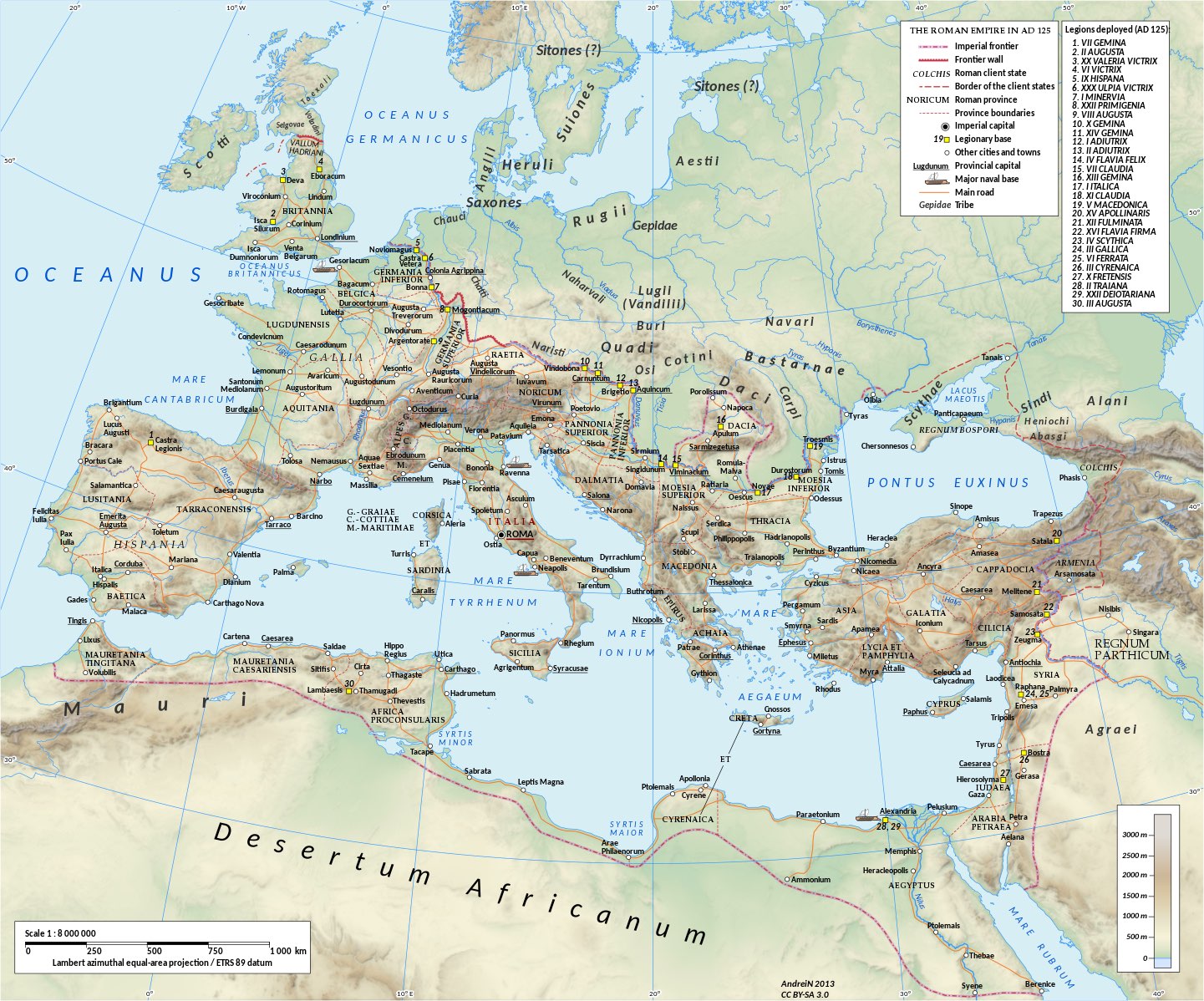
The Julio-Claudian Dynasty
The historian Tacitus described in detail the Roman Senate’s reaction to Augustus’ death in 14 CE. Some Senators hoped for a return to the Republic, while others assumed Augustus’ stepson would inherit his powerful position. The scales were heavily weighted in favor of a new Emperor for, as Tacitus points out, most Senators by 14 CE had never lived under a functioning Republic. A critical question remained of how to determine succession. Because of the untimely deaths of other possible candidates, Augustus eventually adopted his stepson Tiberius Claudius Nero, son of his wife Livia from her first marriage. In the final years of his life, Augustus gradually shared more unofficial powers with Tiberius to smooth the process of succession. Augustus’ plan worked; after a brief debate, the Senators conferred upon Tiberius all of Augustus’ previous powers. Tiberius’ succession is the reason historians refer to the first Roman imperial dynasty as the Julio-Claudians.
Tiberius, a decorated military general in his youth, appears in sources as a sullen and very likely cruel individual. He appears to have been a rather reluctant emperor who preferred life out of the public eye. In 26 CE, Tiberius retired to Capri for the final 11 years of his rule. It is a testament to the effective bureaucratic system of the Roman Empire that the 11-year absence of the emperor was hardly felt, with the exception of a foiled plot against Tiberius by his chief trusted advisor in Rome, Sejanus.
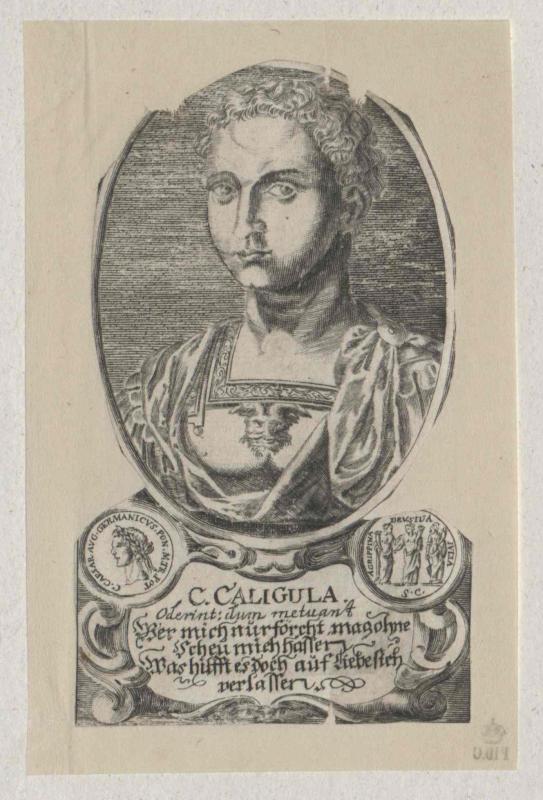
Like Augustus, Tiberius had a difficult time selecting a successor as, repeatedly, each relative identified as a candidate died an untimely death. In the end Tiberius adopted as his successor his grandnephew Gaius Caligula, or “little boot,” son of the popular military hero Germanicus. Caligula began his reign with full support of both the people and the Senate and an unprecedented degree of popularity, but he swiftly proved to be mentally unstable and bankrupted the state in his short rule of just under four years. In 41 CE, he was assassinated by three disgruntled officers in the Praetorian Guard, ironically the body formed by Augustus to protect the emperor. Caligula’s assassination left Rome in disarray.
The biographer Suetonius reports that as the Senate met and planned to declare restoration of the Roman Republic, the Praetorian Guard proclaimed Claudius the next emperor. Claudius was the uncle of Caligula and brother of Germanicus. Claudius was a productive emperor, repeatedly surviving plots against his life by first one wife and then the next. In 54 CE, Claudius died, widely believed to have been poisoned by his wife, Agrippina the Younger. Claudius’ son from an earlier marriage was poisoned soon after his death so his successor was Nero, his stepson, only sixteen years old when he gained power.
Nero gradually alienated the Senate, the people, and the army over the course of his 14-year rule. He destroyed his own reputation by performing on stage, behavior considered disgraceful in Roman society. Nero is believed to have caused the great fire of Rome in 64 CE to free up space in the middle of the city for his ambitious new palace, the Domus Aurea, or Golden House. The last years of Nero’s reign were dominated by provincial rebellions A revolt broke out in Judea in 66 CE when the governor of Gaul, Gaius Julius Vindex, rebelled against Nero. The revolt of Vindex proved to be the end of Nero. Vindex convinced the governor of Spain, Servius Sulpicius Galba, to join the rebellion and proclaim himself emperor. While the rebellion of Vindex was quickly squashed and Vindex himself committed suicide, popular support for Galba grew just as quickly. Terrified by rumors of Galba marching to Rome, Nero committed suicide in 68 CE. His death marked the end of the Julio-Claudian dynasty.
Political Instability
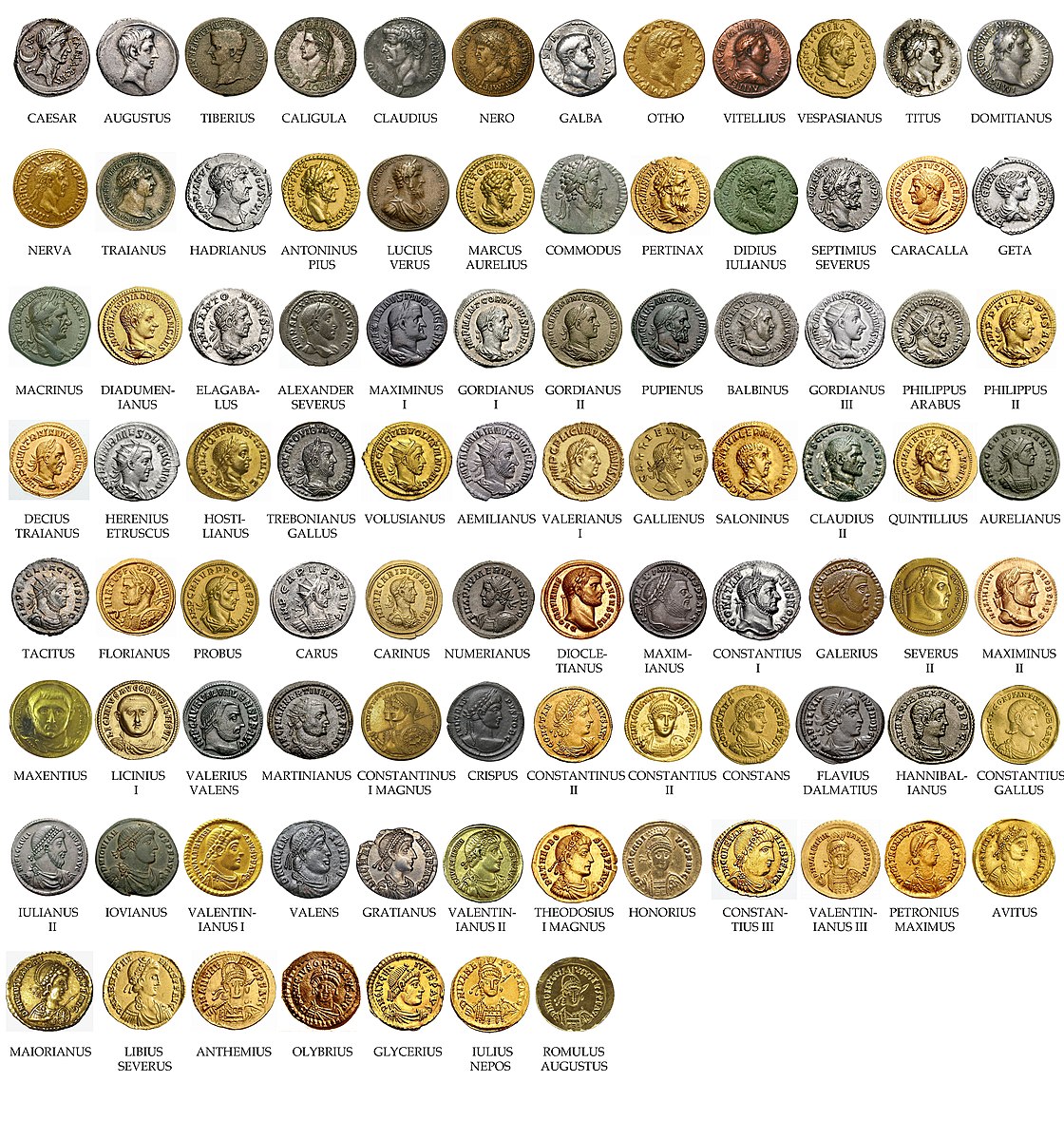
The year and a half after Nero’s death saw more intensive civil war and instability throughout the empire than any other period since the late Republic. The year 69 CE became known as the ‘year of the four emperors’ as four emperors in succession came to power: Galba, Otho, Vitellius, and Vespasian. Each challenged his predecessor to a civil war and each was swiftly defeated by the next challenger. The year of the four emperors made clear emperors could emerge from outside of Rome, as seen by Galba’s proclamation as emperor in Spain. Also, the army clearly could make emperors, as each of the four emperors in 69 CE was proclaimed emperor by his troops. These changes indicated the declining importance of Rome as a center of political power and the decline in importance of the Senate.
Vespasian, the only successful emperor of 69 CE, founded the Flavian dynasty. A talented military commander, Vespasian commanded a major military force in 69 CE fighting to subdue the Jewish Revolt. Vespasian was the only one of the four emperors of 69 CE who had grown sons and thus clear successors. His older son, Titus, was already a popular military commander and cemented his reputation even further with his conquest of Jerusalem in 70 CE. The Flavian dynasty did not last long, however. It ended in 96 CE with the assassination of Emperor Domitian, Vespasian’s younger son.
During the period from 96 CE to 180 CE, known as the ‘Era of Five Good Emperors‘, an alternative to traditional bloodline succession was attempted as each emperor adopted a talented leader as his successor. The result was what Edward Gibbon, the 18th century British historian of Rome, called “the happiest age” of mankind. Yet evidence suggests that while Rome and other major urban centers flourished, life in the periphery could be a very different experience.
Learning in Action – Roman Emperors
View the website: “Rome’s Pivotal Emperors,” BBC 2001
Link: https://www.bbc.co.uk/history/ancient/romans/romespivotalemperors_gallery.shtml
Center Versus Periphery in the Roman Empire
Much of the existing evidence from the Roman Empire comes from Rome and Italy. Yet, as is so often the case with empires, life in Rome was not representative of everyday life for those throughout the empire. Problems the residents of Rome contended with differed considerably from what residents of distant provinces experienced. Careful examination of two sources from the 2nd century CE reveals that the relationship of the Roman Empire to those living in the provinces in the periphery was often uneasy. Writing about two different provinces within a half-century of each other, Pliny the Younger and Apuleius convey the complicated blessings of living in a province under Roman rule yet far away from Rome. Surprisingly, most Roman governors received just one type of personnel to assist them with their duties: a flute-player to play during sacrifice ceremonies. Military forces were expensive to maintain and needed for emergencies in those areas of the Empire considered at the most risk for rebellion or outside attack, thus most governors did not have a legion stationed in their province.
A critical source of information about how Roman provincial governments functioned is the prolific letter-writer Pliny the Younger, governor of the province of Bithynia. Pliny was a cautious and conscientious governor, and consulted the emperor Trajan on every issue he encountered in his province. Luckily for us, their correspondence survives. Pliny’s letters reveal a myriad of problems a governor was expected to solve and dilemmas that arose: staffing personnel for prisons (can one use slaves as prison guards?), building repairs and water supply, abandoned infants and their legal status (slave-born or free?), and what to do with Christians in the province. The emperor Trajan patiently responded to each letter received from Pliny and placed stability and peace in the province foremost in his concerns. For instance, with regard to the issue of Christians in Bithynia, Trajan recommended Pliny to not worry about tracking down Christians in his province as they were not a threat.
Another perspective from the periphery comes from the novel Metamorphoses written by the North African intellectual Apuleius sometime in the latter part of the 2nd century CE. The protagonist of the novel, Lucius, is a curious intellectual traveling through Greece and, through a magic experiment gone wrong, is accidentally turned into a donkey. For the remainder of the novel Lucius, in his donkey form, is stolen, traded, beaten, and abused, until finally rescued by the Egyptian goddess Isis, whose service he then enters as a priest. Throughout his travels, Lucius’ observations reveal the limits of Romanization in the remote parts of Greece. Law and order are largely absent, highway robbery simply a normal part of life, and on the occasion when a poor farmer runs into a Roman soldier on the road, the soldier forcibly requisitions the farmer’s sole possession: his donkey. Apuleius reveals the dark side of the Pax Romana. The Empire was at peace, and few attacks were happening on the frontiers. But life in the provinces was anything but truly peaceful.
Reading the Past – Roman view of European ‘Barbarians’
Read: “Julius Caesar: The Germans, c. 51 BCE” from A Source Book of Mediaeval History: Documents Illustrative of European Life and Institutions from the German Invasions to the Renaissance, edited by Austin Ogg, 1907.
Link: https://sourcebooks.fordham.edu/source/51caesar-germans.asp
EMPIRE IN DECLINE
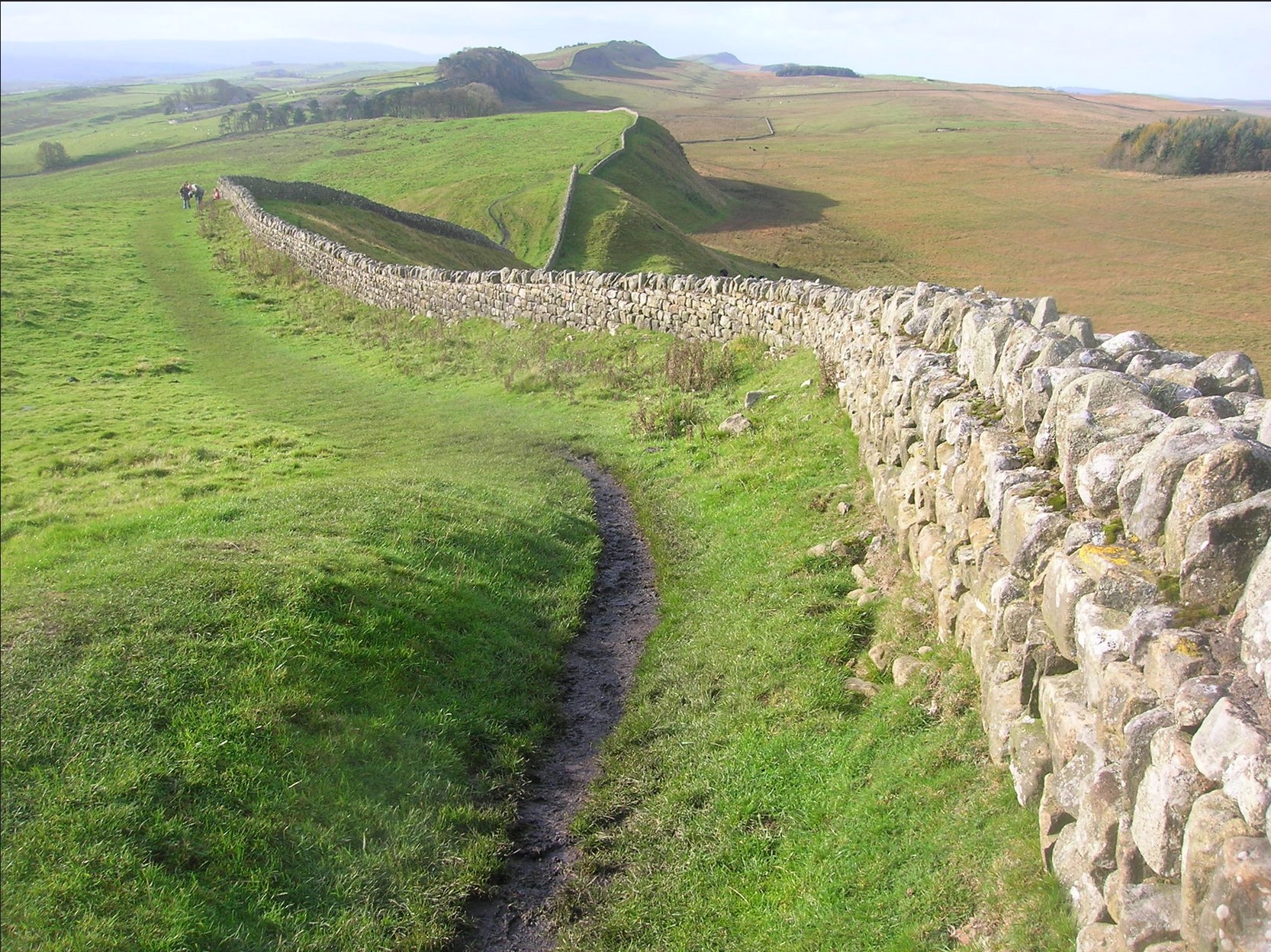
During the rule of the emperor Trajan in the early 2nd century CE, the Roman Empire reached its greatest extent, stretching to Britain in the west, slightly beyond the Rhine and Danube river in the north, and including much of the Near East and north Africa. But the natural frontier offered by the Rhine and Danube rivers made it difficult for the Romans to maintain control over the territories on the other side of these rivers. In the North where Roman forces struggled to fight off the warrior tribes in northern Britain, two 2nd century CE emperors – Hadrian, and later Antoninus Pius – built walls to separate the un-Romanized tribes from the territory under Roman control.
A major challenge for Roman emperors was the location of the empire’s capital. When the Roman Empire consisted of Italy, Rome’s location in the middle of the Italian peninsula was an ideal location. As the empire became a Mediterranean empire, the center of Rome was a great distance from problem frontiers. Emperors over the 2nd and 3rd centuries spent increasingly less time in Rome. Diocletian split the Empire in 293 CE into four administrative regions, each with a regional capital, significantly diminishing the importance of the city of Rome. Then in 330 CE, the emperor Constantine permanently moved the capital of the empire to his newly built city of Constantinople, constructed on the site of the older Greek city of Byzantium.
After 138 CE, Rome’s emperors stopped expanding as Roman troops were spread too thin to defend all the borders. The mobile, flexible forces that had been the basis of Roman power during centuries of conquest became largely a passive guard force stationed in fortresses and lookout posts along the borders. There were not enough citizens of Rome, and certainly not enough who wanted to serve in the army, to be stationed throughout the frontiers; thinly spread Roman forces had to be augmented by recruits from the provinces. Most recruits from the provinces were not Roman citizens and had different reasons for joining the Roman army from those of earlier Roman forces. Many were from conquered populations, joining the army for steady pay and Roman citizenship. Their loyalty was less to Rome and the emperor, rather they sought benefits they would receive as citizens. Most had never seen the city of Rome and were unfamiliar with Roman history or responsibilities associated with citizenship. Because they trained at frontier forts between regular duty shifts, training was uneven, certainly not up to the standard of former conquering Roman legions. Many provincial recruits did not speak Latin, and their commanders and trainers often spoke no Frankish, Saxon, Gothic, or any other language, creating debilitating communication problems.
As a result, borders of the Roman empire were guarded by troops with questionable loyalty to Rome and limited skills. To overcome this problem border generals created a system encouraging personal allegiance, a form of commander cult. Local commanders were in charge of paying the troops which encouraged deeper personal loyalty to individual commanders rather than the Emperor or state. Recruiting from non-Romans, especially on frontiers, was termed the ‘barbarization’ of the Roman army. The result was the transfer of loyalty of the army from the empire to individual commanders. This led to the decline of the army’s effectiveness – decreasing its cohesive fighting ability as well as increasing the likelihood commanders would press personal claims to power. The decline in Rome’s ability to hold on to conquered territories led to the retreat of Roman Empire borders. Roman leaders called this ‘defense in depth’ but this retreat was visible evidence of Imperial decline.
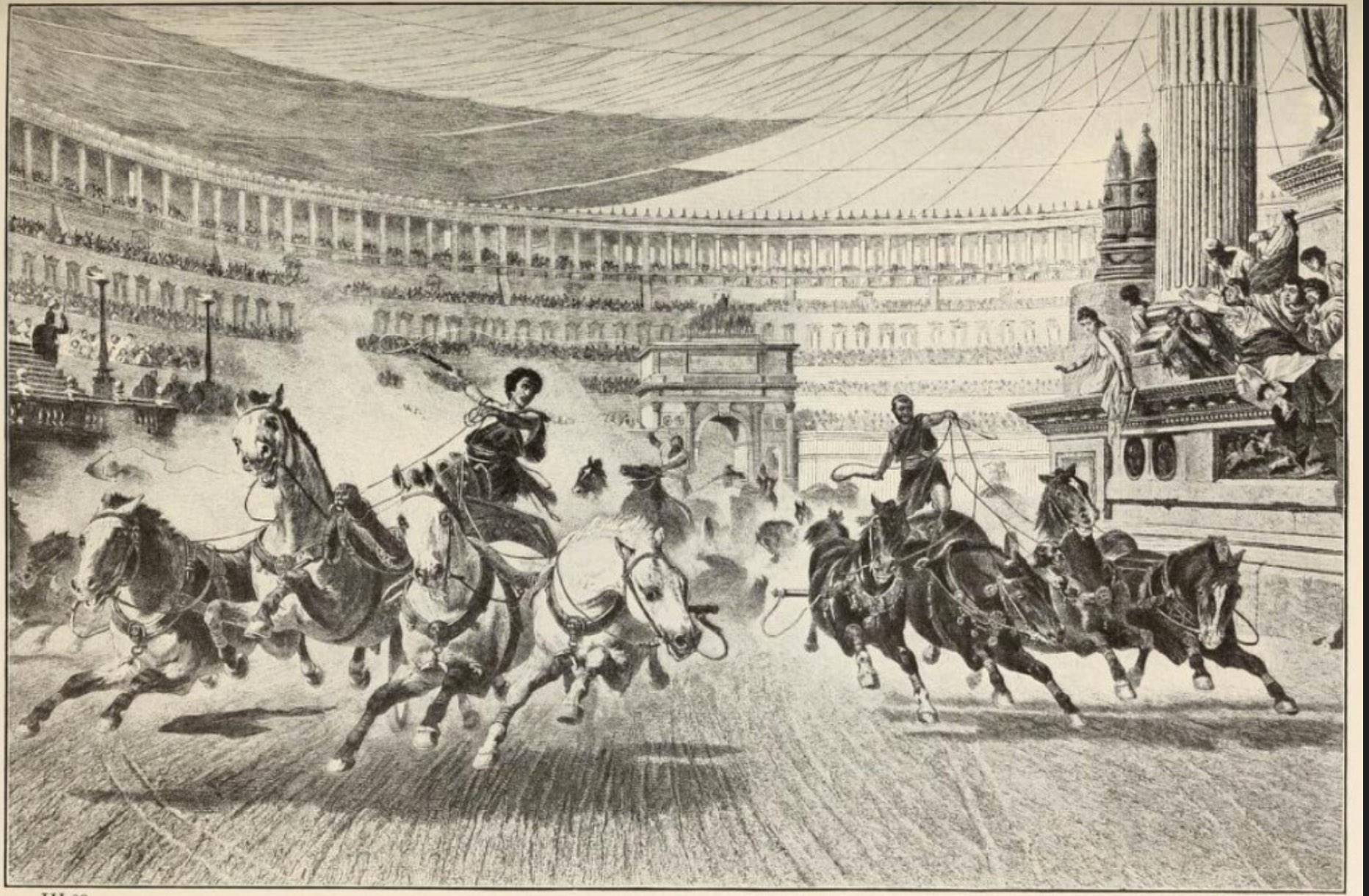
Contributing to internal decline were intensifying social divisions at home. Unable to make a living on the land, rural populations flocked to cities in desperation. Cities boomed, in particular desperately poor slum areas dominated by overcrowding, filth, disease and crime. To address the threat of political upheaval from growing masses of poor, disaffected subjects, Roman emperors failed to deal with underlying problems through land distribution or addressing poverty. They relied instead on a flawed and costly policy of bread and circuses to prevent social upheaval. Impoverished citizens were given small rations of bread, oil and wine to prevent desperate hunger, and distracted from their suffering by state-funded blood sports, the famed Roman ‘games’. Arenas hosted chariot races, gladiator battles, fights between animals and matches between condemned people, fighting in front of cheering crowds. Some social historians argue blood sports were meant to instill pride in Rome’s military culture and state, to buttress the authority of Emperors. State-funded bread and circuses perhaps delayed rebellion but did not solve underlying social problems; in the end they dramatically increased state expenditures and debt, accelerating Rome’s decline.
Learning in Action – Rise and Fall of the Roman Empire
Watch the video of the animated map: “History of Rome and the Roman Empire,” The Map As History 2019
Early Christianity and the Roman Empire
One problem in Bithynia during Pliny’s time as governor in 111–113 CE involved procedural questions about how to treat Christians in the province. Pliny did not have much knowledge about them but was struck by what he described as their stubbornness in clinging to their faith, even when threatened with death. As he pointed out in his letter to Trajan, this stubbornness alone merited punishment. Pliny’s perspective is one of the earliest non-Christian sources about the new religion and indicates how quickly this faith had spread over the Empire. But how and why did the new religion spread so rapidly over the Empire? Several different cults and self-proclaimed prophets periodically appeared in the Roman world, yet none had the long-term impact of Christianity. Just two centuries after Pliny’s letter, Christianity had become the religion of the Roman emperor himself.
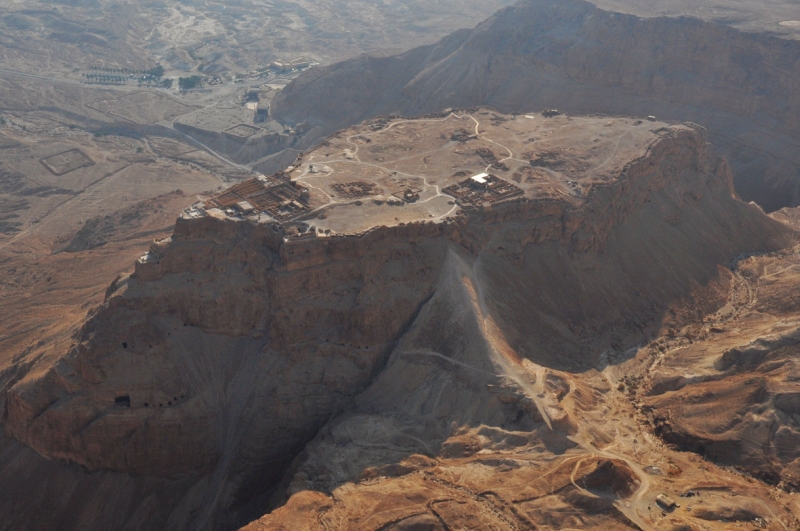
The history of early Christianity is based on primary sources from the perspective of insiders and outsiders. The New Testament is a collection of primary sources by early Christians about their movement, with some letters composed only twenty-five years after Jesus’ crucifixion. The emergence of the Christian religion from the Jewish faith begins with the story of Jesus of Nazareth, born sometime between 4 CE and 6 CE (based on revised Christian calendar dates). Jesus was born during a period of tumult in the Roman occupied province of Judea. There were several bloody clashes between Jewish subjects and Roman forces, including the months-long siege of the Jewish stronghold at Masada. A number of Jewish sects were active in protests, some violent, and the Romans responded with brutal repression. Some in the Jewish community believed that during this time of turmoil, the emergence of a ‘messiah’, a king and savior described by Hebrew prophets, was imminent. This savior would lead the Jews in rebellion against Roman rule. Expectations were limited to the temporal expectation that this savior would bring about God’s kingdom on earth – a Jewish state independent of Rome.
In this fraught and turbulent atmosphere, Jesus of Nazareth shared his teachings. While these messages were part of the Jewish faith, they were markedly different from traditional Jewish beliefs. For example Jesus’s emphasis on the equality of all before God differed from traditional societal divisions reinforced by Jewish law. Some in the Jewish community believed Jesus of Nazareth was the awaited messiah and his teachings represented a divine religious authority. But this was not the belief of the mainstream Jewish community nor religious leaders, some of whom were deeply concerned the perception of Jesus as the Messiah was wrong and divisive to the Jewish community fighting against Rome. Roman prefect Pontius Pilate was concerned about the destabilizing rift emerging in the Jewish community in Palestine. The hostility and concerns of Jewish leaders and Roman officials led to the arrest of Jesus of Nazareth. He was condemned to death and executed by crucifixion. Followers who believed Jesus rose from the dead viewed this resurrection as affirmation of the promise of a heavenly kingdom, and they were passionately convinced Jesus of Nazareth was the Messiah of God. They came to be called Christians because they believed Jesus was the Christ (from the Greek word for savior). The first Christians were Jews – Christian Jews – a minority sect within the larger Jewish community.
Evidence of the New Testament, portions of which were written as early as the 60s CE, indicates earliest Christians were from all walks of life. Paul, for instance, was a tent-maker. Some, like Paul, were Roman citizens, others were non-citizen free males of varying provinces and many were women and slaves. Early Christianity appears to have been predominantly an urban religion. Paul’s letters address churches in different cities throughout the Greek-speaking world, indicating networked relationships between these early churches, despite the physical distances. Through that network, churches carried out group projects such as fundraising for areas in distress and assisting Christian missionaries in their work. By the early 2nd century CE, urban churches were led by bishops, overseers for spiritual and practical matters of the church in their region.
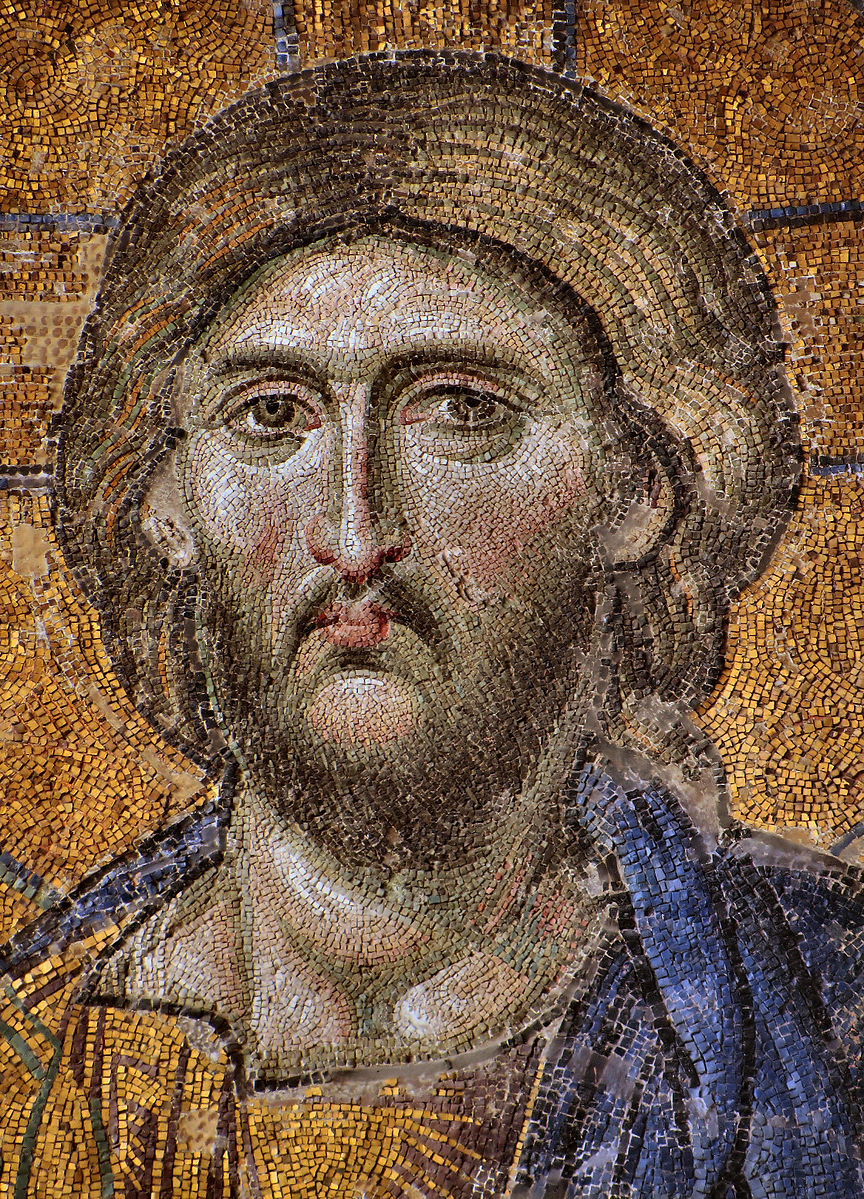
The early Christian movement was revolutionary; in several respects, it went completely against every foundational aspect of Roman society. The Christian view of one God was very different from polytheistic conceptions of gods that dominated throughout the ancient Mediterranean. For early Christians, their God’s willingness to sacrifice for humanity and the sins of the world indicated they were all equally important to him, and the social positions and regional differences in the Roman world had no significance in God’s eyes. Many early Christians believed Jesus was coming back soon; they eagerly awaited his arrival, which would erase all inequality and social distinctions.
By contrast, traditional Roman society was extremely stratified. Though the conflict of the orders was resolved by the mid-Republic, sharp divisions between the rich and poor remained and intensified over the centuries of the Imperial era. Social mobility was possible, for instance slaves could be freed and within a generation their descendants could be Senators, yet significant mobility was the exception rather than the rule. Gender roles in Roman society remained extremely rigid as all women were subject to male authority. The paterfamilias, or head of the household, had the power of life or death over all living under his roof, including in some cases adult sons who had their own families.
Christianity challenged these traditional relationships, ignoring social differences and treating the slave and the free person the same. Christianity also espoused a greater degree of freedom for women than was heretofore known in the ancient world. Early Christianity allowed women to serve in the church and remain unmarried. The early churches were community affairs with very little formal structure. As organizational and communication needs increased, along with questions and conflicts regarding Jesus’ teachings, an institutional structure grew to handle them. Early Christian churches appear to have been administered by boards of elders known as presbyters (elders) and deacons (‘those who serve’). By 200 AD, as Christian churches found more members, they began to accept the authority of bishops (episkopoi or ‘overseers’); these bishops were elected by each individual congregation. Bishops were considered the successors to the apostles – inheritors of the knowledge of Christ – and became the arbiters of Christian doctrine, extending their authority over the congregations of outlying towns and villages. The bishops’ ability to maintain church solidarity, even during times of economic and social difficulties, was certainly an important element in Christianity’s survival through tumultuous periods. This institutionalization of Christian communities led to the emergence of the Roman Catholic Church; Catholic meaning ‘universal’ in Latin. Rome was the center of this Church, headed by a Pope.
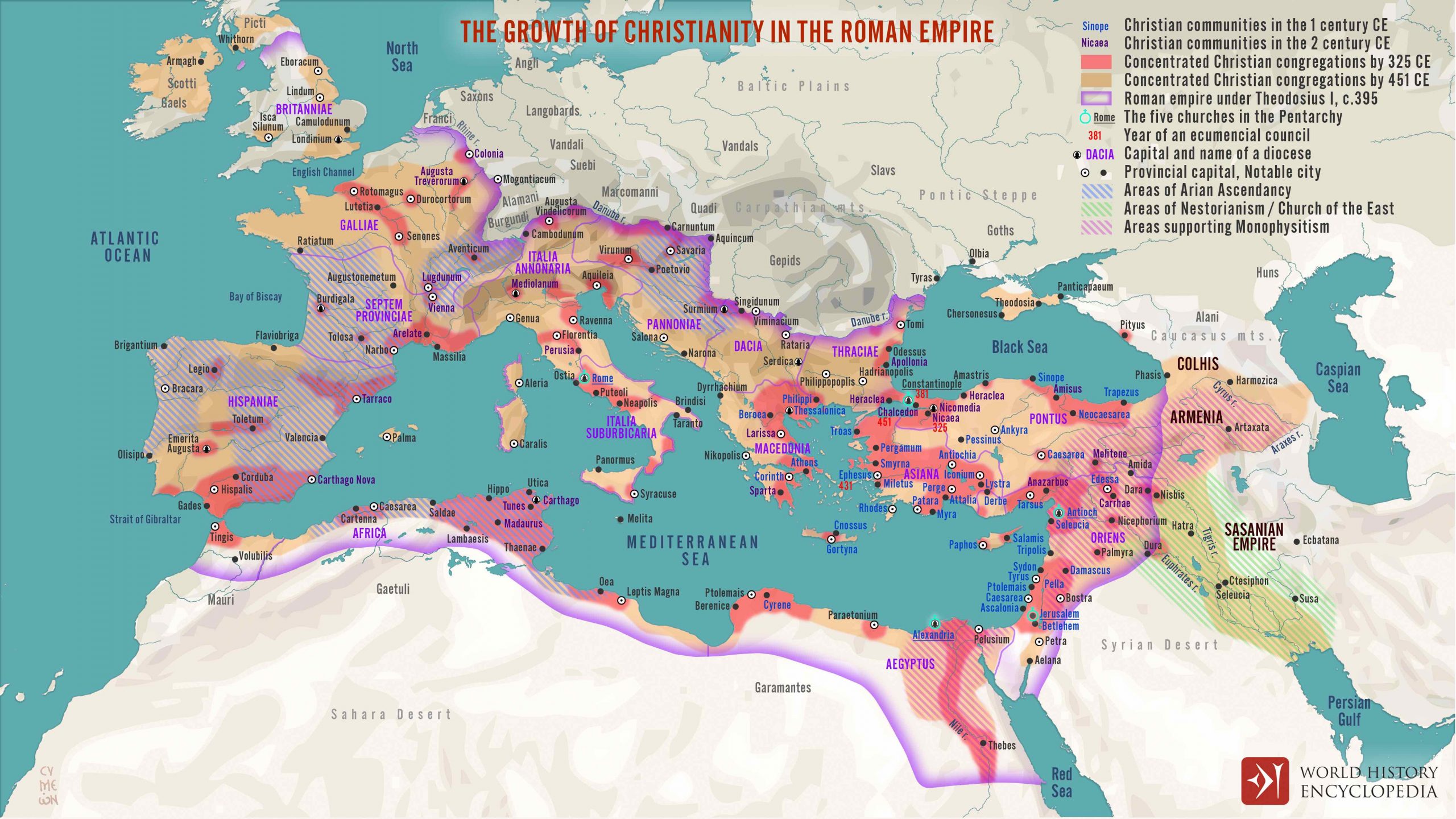
Learning in Action – Early Christianity
Watch a segment of the video: “From Jesus to Christ: The First Christians, Part Two,” Frontline 1998
Link: https://www.youtube.com/watch?v=GXqFvfCaFwY&t=4821s
Watch from time mark 1:17:45 to 1:28:40
THIRD-CENTURY CRISIS AND LATE ANTIQUITY
While the 2nd century CE was a time when the Empire flourished, the 3rd century was a time of crisis. Political instability and civil wars demonstrated the Empire had become too large to be effectively controlled by one ruler. Increasing pressures on the frontiers required emperors to spend much of their time on campaigns, resulting in the declining importance of the city of Rome. By the end of the 3rd century, the empire was divided. This system of rule lasted, with some interludes, until the last Western emperor Romulus Augustulus was deposed in 476 CE. While the political narrative of the 3rd century and Late Antiquity could be described as a story of decline and the fall of the Roman Empire, it was also a period during which Christian culture flourished and replaced the traditional Roman pagan mode of thinking.
The Third-Century Crisis and Diocletian
The 3rd century crisis (235–284 CE) was characterized by political, social, and economic upheaval across the Empire. Most new emperors were military generals, proclaimed by their troops on campaign; most had no previous political experience and no clear program for ruling the empire. The Empire was also dealing with increasing pressures on the frontiers, as well as a plague that devastated populations, famine, declining soils, crops and forests, and rampant inflation. Roman emperors, starting with Nero, had been debasing the Roman coinage, but during the 3rd century crisis inflation hit in full force. 3rd century turmoil made clear a single emperor stationed in Rome was no longer equipped to deal with the challenges of ruling such a vast territory. This was recognized by the man who ended the crisis: the emperor Diocletian. Born to a socially insignificant family in the province of Dalmatia, Diocletian had a successful military career. Proclaimed emperor by his troops in 284 CE, Diocletian displayed a political acumen none of his predecessors in the 3rd century possessed. Diocletian established a new system of rule: the Tetrarchy, or rule of four. He divided the empire into four regions, each with its own capital.
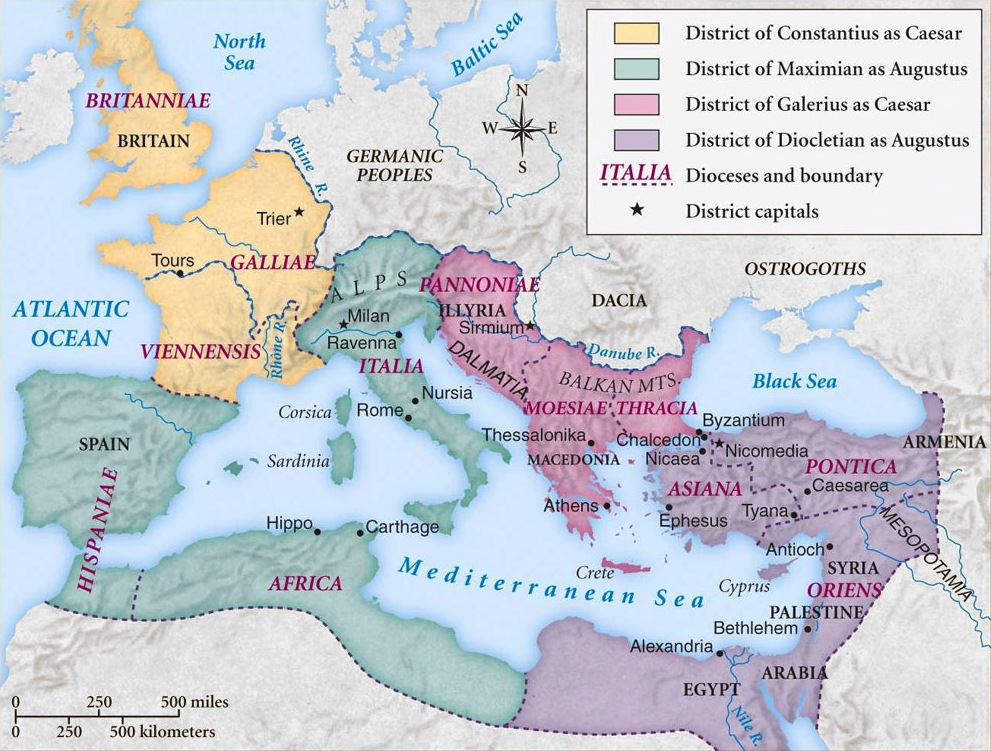
Two regions of the Tetrarchy were ruled by senior emperors, named Augusti (“Augustus” in the singular), and two were ruled by junior emperors, named Caesares (“Caesar” in the singular). One of the Augusti was Diocletian himself, with Maximian as the second Augustus. The two men’s sons-in-law, Galerius and Constantus Chlorus, became the two Caesares. In addition to reforming imperial rule, Diocletian attempted to address other major problems such as inflation by passing the Edict of Maximum Prices. This edict set a maximum price that could be charged on basic goods and services in the Empire. He also significantly increased the imperial bureaucracy. Some modern historians have described Diocletian as the most significant Roman reformer since Augustus.
Diocletian’s political experiment successfully ended the 3rd century crisis. But while successful in restoring stability to the Empire, the question of succession was a far greater problem than Diocletian anticipated. Hoping to provide a smooth transition of power, Diocletian abdicated in 305 CE and required Maximian to do the same. The two Caesares, junior emperors, were promptly promoted to Augusti, and two new Caesares were appointed. The following year, however, Constantius Chlorus, a newly minted Augustus, died. His death resulted in a series of wars for succession, which ended Diocletian’s experiment of the Tetrarchy. The wars ended with Constantius’ son, Constantine, reuniting the entire Roman Empire under his rule in 324 CE. In the process, Constantine also brought about a major religious shift in the Empire.
From Constantine to the Last Pagans of Rome
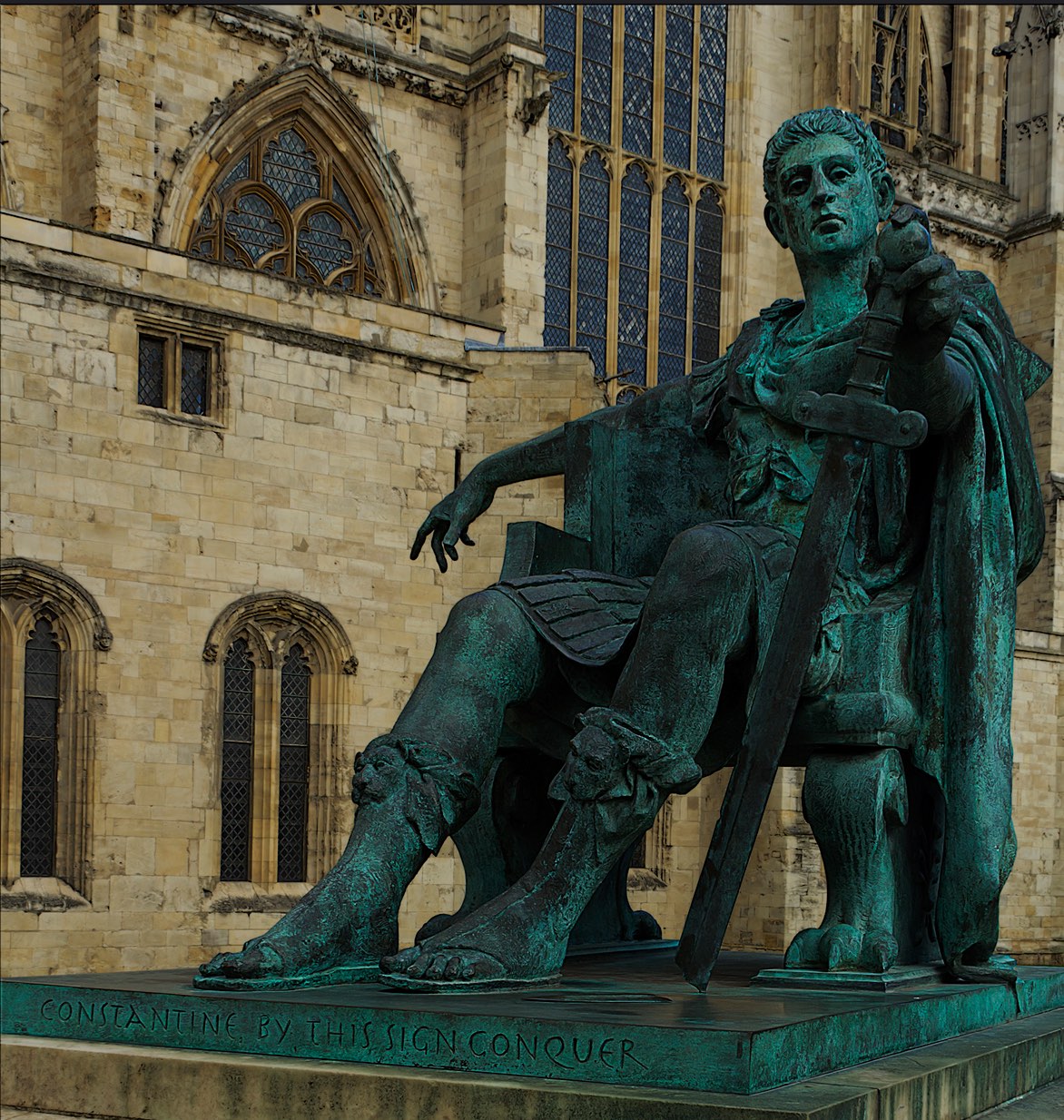
While traditional Roman religion incorporated a broad variety of new cults and movements, Christianity’s fervent monotheism challenged traditional Roman religion, transforming Roman ways of thinking about religion. By the early 4th century CE, historians estimate about ten percent of those living in the Roman Empire were Christians. This largely underground faith then grew exponentially due to the emperor Constantine’s endorsement. Sources at the time described how Constantine, before a major battle in 312 CE, had a dream or a vision in which Christ himself told Constantine to place the Greek letters X and P (Chi, Rho, the first two letters of Christ’s name in the Greek alphabet) on his soldiers’ shields in order to assure victory.
Grateful for his subsequent victory, Constantine played a major role in the governing of the church over the course of his rule, though he was not baptized himself until he was on his deathbed. Constantine summoned the First Council of Nicaea in 325 CE, a gathering of major Christian bishops from all over the Empire. The Council settled several doctrinal issues, including the question of the relationship of God the Father and God the Son, affirming the doctrine of the Trinity. The Council set a significant precedent for communication between bishops in the Empire. It was the first of seven major ecumenical councils that ended with the Second Council of Nicaea in 787 CE. The councils allowed churches of the Eastern and Western parts of the Roman Empire to work together on key doctrines and beliefs of the church.
Constantine’s rule also marked the end of the city of Rome as capital of the Roman Empire. Upon reuniting the Empire in 324 CE, Constantine established his capital at the old location of the Greek city of Byzantium, renaming the city Constantinople. The location had strategic advantages for the Empire. It had an excellent harbor, and was close to the Persian frontier as well as the Danube frontier, a troubled area that required attention from the emperor. By building this new city, referred to as ‘New Rome,’ Constantine sent the message his rule was a new beginning for the Roman Empire, now a Christian empire.
Reading the Past – Founding of Constantinople
Read: “Sozomen (d. c. 450 CE): Constantine Founds Constantinople, 324 CE” from Readings in Ancient History: Illustrative Extracts from the Sources, edited by William Stearns Davis, 1912-1913.
Link: https://sourcebooks.fordham.edu/ancient/sozomen-constantinople1.asp
With the Emperor’s backing, Christianity grew exponentially over the 4th century CE, and in 395 CE, Emperor Theodosius banned traditional Roman religion and other forms of paganism. A mere 83 years after Constantine’s initial expression of support for Christianity, it had become the official religion of Rome. Paganism continued to survive for another century or so, but without state support, it slowly died out. A new sect had started in Judaea in the 1st century CE by followers of a crucified Messiah, then spread outward like a wildfire to all parts of the empire. This faith challenged and gradually replaced the worship of the traditional gods, bringing even the emperors into its fold.
Decline and Fall of the Roman Empire
Constantine continued to face economic difficulties as well as threats from Goths and other tribal ‘barbarians’. In response, Constantine continued the practice begun by Diocletian of freezing occupations to prevent people from running away from their responsibilities, which many were doing in the face of onerous taxes and to survive the general economic turmoil. Artisans, farmers, even administrative officials faced with what appeared to be insurmountable economic difficulties attempted to escape the empire altogether. Constantine also froze wages and prices in an attempt to control the economy. This failed miserably, despite the fact the penalty for overcharging was death. Constantine, as Diocletian had done before him, inflated the Roman currency in an attempt to make it go farther. This artificial solution had little effect other than inflating prices and problems continued.
As political and military effectiveness declined, local residents began to take matters into their own hands. Towns, including Rome, constructed or reinforced defensive walls. Peasants and artisans would go to governors of towns or walled manors to find refuge in the event of an invasion. These people were granted refuge, usually in return for a promise of work performed for those who controlled the defense. Often these peasants were bound to the land they worked, and the land became the property of the manor or town governor. These governors might use their wealth to buy mercenaries to fight the invading barbarians or to create their own local armies. As invasions continued to focus on cities – centers of wealth and power – the wealthy began to move further and further out into the countryside where they could avoid pillaging. There they built fortified manors for defense against barbarian raiders and the remnants of Roman state power.
Travel between towns and manors became dangerous due to the likelihood of meeting invading forces or bands of thieves. In many cases, as communication was cut off, and technology transfer limited, these manors and isolated towns devolved to a more primitive way of living and governing, with local law and power taking more and more precedence over the law of Rome. In this way, the shape of Medieval feudalism became visible in the declining years of the Roman Empire.
Though the city of Rome was greatly diminished, the Pope remained there as a central authority figure for the Western half of the Roman empire, while the Emperor in Constantinople had little or no contact with the Western Empire. In 476 CE, Romulus Augustus, the last Western Roman Emperor, abdicated his throne and lost his head to a Lombard chieftain named Alaric. For many historians, this is considered the end of the Roman Empire that dominated the Mediterranean world for centuries.
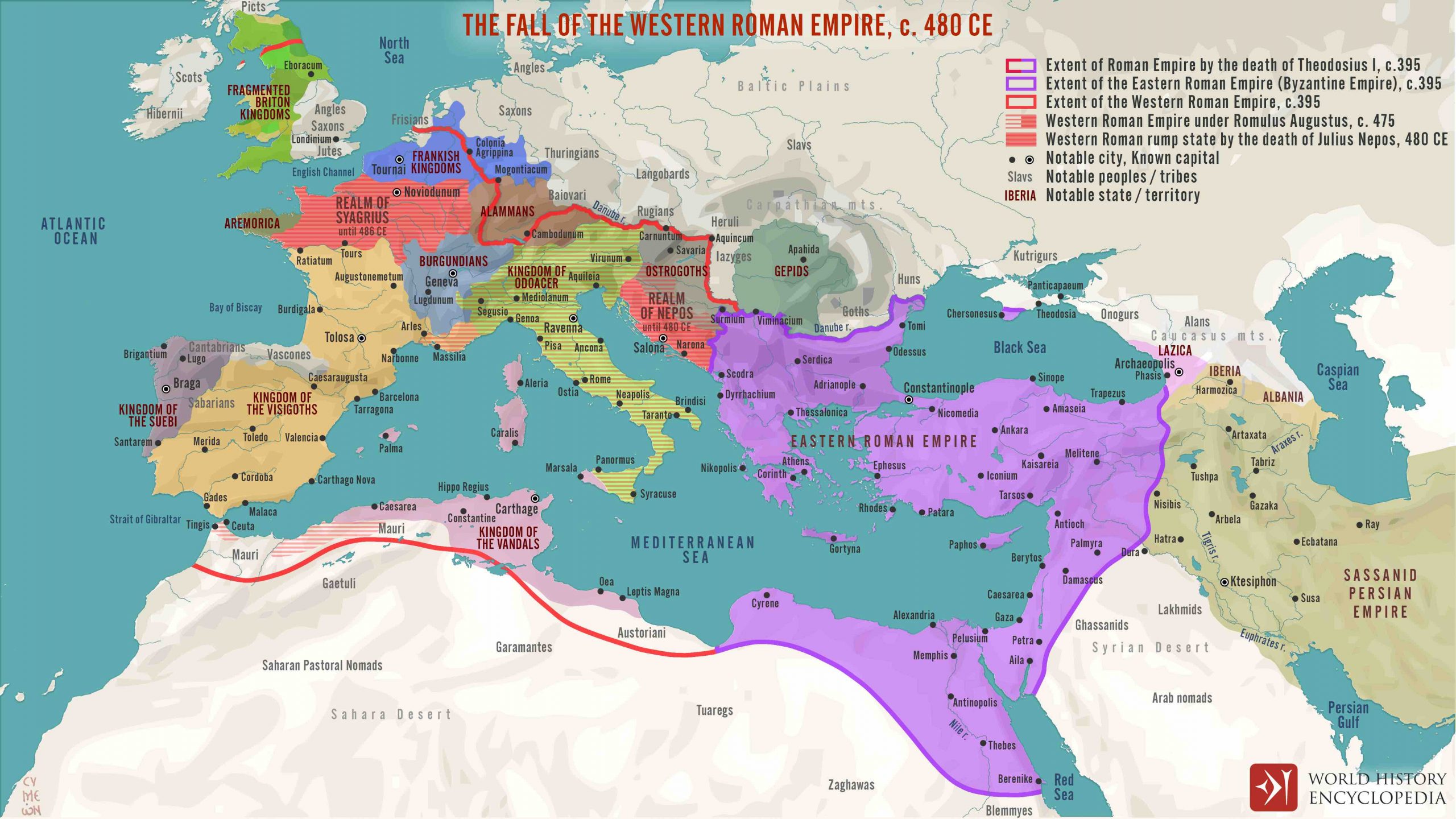
Learning in Action – Fall of the Roman Empire
Read: “How Climate Change and Plague Helped Bring Down the Roman Empire,” Kyle Harper, Smithsonian Magazine 2017.
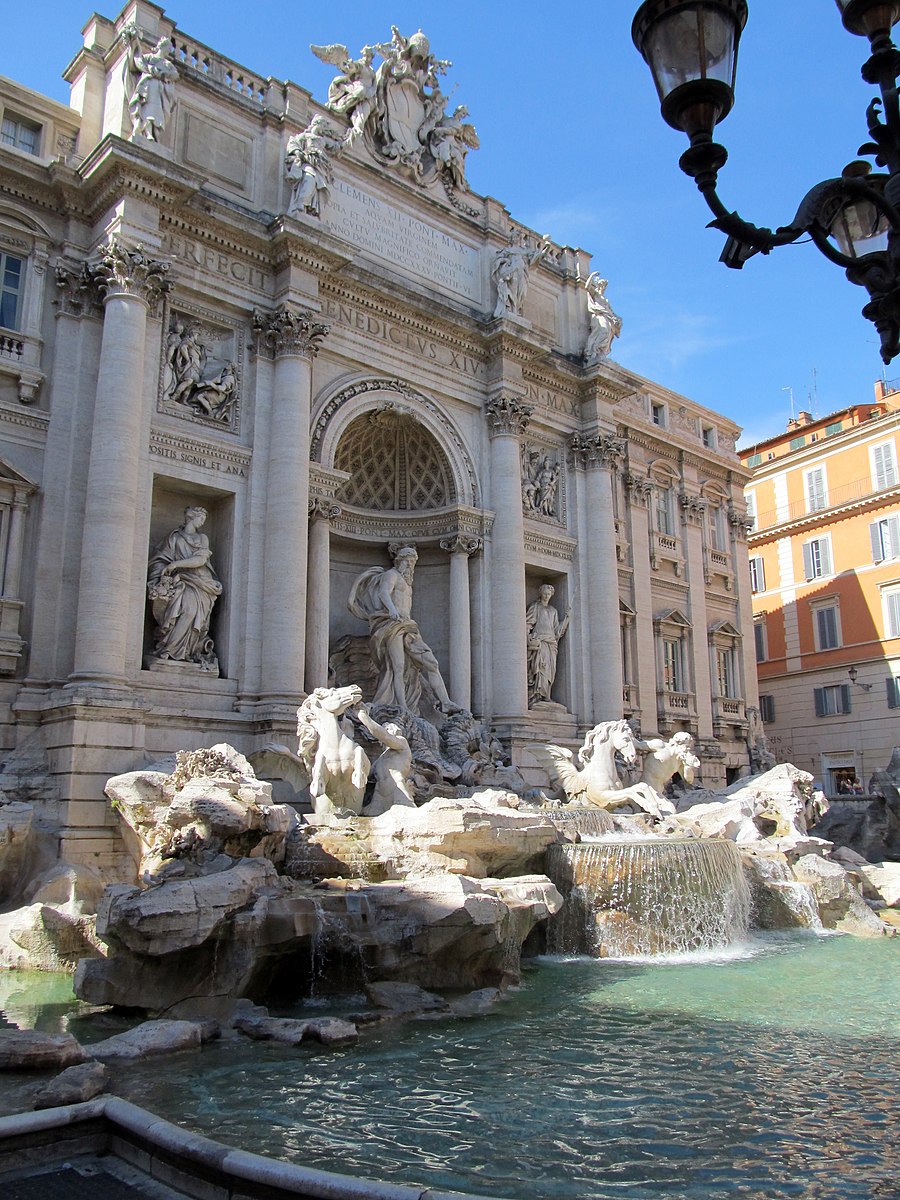
Modern Western societies exhibit visible influences of ancient Greece and Rome in scholarship, architecture, art, literature, and politics. Not surprisingly, comparisons are often made between ancient classical roots and modern Western based societies. Historians and pundits seem especially interested in comparing ancient Rome to the United States. As historian Mary Beard states, “…since the Renaissance at least, many of our most fundamental assumptions about power, citizenship, responsibility, political violence, empire, luxury, beauty, and even humour, have been formed, and tested, in dialogue with the Romans and their writing” (Beard 2015). Historians, politicians, commentators and pundits refer to lessons from, and parallels with, ancient Rome since the U.S. is also a prosperous Republic that grew to become a world power. Yet historical events do not predict future outcomes, and the application of historical insights can be misapplied or even twisted to support modern political biases and agendas. Misuse of historical parallels can obscure accurate appreciation of contemporary realities.
Certainly there are many similarities between the United States and ancient Rome. Shared historical experiences include establishment of a global reach and influence based on impressive military and economic power, as well as manifest technological prowess and achievements, and growing populations made up of diverse populations. The political system of the Roman Republic clearly informed and influenced the drafters of the U.S. Constitution, reflected in use of political vocabulary based on Roman politics e.g. Senate, dictator and plebiscite. Western popular culture is littered with references to Rome’s historical events, from Nero fiddling while Rome burned, to Julius Caesar’s crossing the Rubicon, to images of the blood sports in the Coliseum. Roman philosophy and literature is still read, analyzed and quoted. Western art and architecture is clearly beholden to classical influences, and Latin phrases such as carpe diem and in vino veritas are part of our modern Western vernacular.
Commentators point to more troubling parallels, including contemporary problems in Western states that appear to mirror those experienced by a declining Roman state, for example growing socio-economic divisions, civic decline and strife, and political instability. Those on both the left and right of the political spectrum identify what they see as cautionary lessons in Roman history. For example, those eager to emphasize perceived dangers from immigration levels point to the ancient influx of tribal ‘barbarians’ that presaged the sack of the city of Rome and collapse of the Western half of the Roman empire. Others point to current threats to U.S. democratic functioning from the growing divide between rich and poor, political polarization, and destabilizing populist appeals, factors glaringly evident in the declining Roman state. Contemporary concerns about an overstretched U.S. military and draining foreign entanglements, or consolidation of public power in the hands of an oligarchic elite, are sometimes linked to parallels seen in Roman history. For some critics of U.S. conditions, descriptions of Rome’s decline seem grimly familiar including the “…exaggerated sense of self importance coupled with a myopic view of the world; a military overstretched and alienated from civilian society; an imprudent rush toward the privatization of public services; a mounting struggle to police borders; and, finally, the inherent impossibility of managing an environment of such burgeoning complexity” (The Atlantic 2007).
But while parallels can engender greater awareness, attention and vigilance, similarities do not mean history is simply repeating itself. Context changes, and morals and values evolve over time; Roman society and experiences differ greatly from our lives, values and priorities today. Though we can learn from historical experiences, we cannot simply transpose lessons and meaning across millennia. An important example is the issue of migration, past and present. Contemporary voices advocate strict border controls to control ‘invasions’ or influx from migrants, with some explicitly pointing to ancient Rome’s experience of being overrun by outside ‘barbarians’. Critical analyses by Classical historians evaluating the realities of Rome’s treatment of migrants, however, emphasize Rome’s Imperial borders were not fixed with walls and guards; these frontiers were ‘deliberately porous’ allowing needed labor, and economically essential merchants and visitors to enter. Free flowing movement benefited Rome’s economic well-being as well as fostered an enriching diversity of peoples and cultures that benefited the empire. The Roman Empire was characterized by diversity, the absorption and inclusion of several different groups who maintained distinctive identities but assimilated to become part of, and benefit from, the Roman world. A persuasive historical argument can be made that Rome’s inclusion of diversity and fluid borders was in fact a source of its greatness, not decline. As Mary Beard states,“It was an empire built…on the extension of citizenship and the incorporation of outsiders” (Beard 2015).
Another danger in drawing historical lessons from the past is oversimplification. Historians rarely identify just one or two causes of Roman imperial decline. Cumulative problems undermining the Roman Empire included: the declining quality and caliber of the military, over-extension of the empire, failure to adequately maintain military garrisons, internal political decline and rise of erratic, autocratic Caesar rule, growing social-economic differences, the debilitating effects of lead in irrigation pipes, unpopular and escalating tax burdens, economic turmoil, and declining resources due to environmental overuse, misuse and decline. Many factors contributed to the weakness, contraction and ultimately collapse of Roman control, so looking at one or two factors and linking these to contemporary problems is historically flawed.
Application of historical understanding is a vital tool in addressing contemporary concerns, but it must be done with care and without contemporary agendas. As Beard states, “Roman history is always being rewritten, and always has been. It is a work in progress, and the myths and half-truths of our predecessors always demand correction – as our own myths will no doubt be corrected by our successors in due course” (Beard 2015). This astute statement applies to all attempts to learn from the past.
CONCLUSION
After the death of the Emperor Theodosius in 395 CE, the Roman Empire became permanently divided into Eastern and Western Empires, with instability and pressures on the frontiers intensifying, especially in the West. The sack of Rome by the Goths in 410 CE was followed by an equally destructive sack of Carthage by the Vandals in 439 CE. There were continuing raids of Roman territories by the Huns, a nomadic tribe from Eastern Europe, the Caucasus region, and south-eastern China. The Huns experienced an especially prolific period of conquest in the 440s and early 450s CE under the leadership of Attila. While not able to hold on to their conquests after Attila’s death in 453 CE, these attacks further destabilized an already weakened Western Roman Empire. The deposition of the Emperor Romulus Augustulus in 476 CE marked the end of the Roman Empire in the West.
The Eastern half of the Empire, however, continued to flourish for another thousand years. In the East and headquartered in Constantinople, the Eastern Roman Empire continued for another millennium, mixing Roman concepts of law with Eastern art, religion, and mysticism, and Greek philosophy, language, and politics, to create a unique and influential crossroads for world civilizations known as the Byzantine Empire.
The fall of the Roman Empire in the West led a number of tribes to carve out territories, each for its own control. Over the next five hundred years, led by ambitious tribal chiefs, these territories coalesced into loose kingdoms. The Roman Empire was gone, yet its specter loomed large over these tribes; their leaders spoke dialects with Latin influences, believed in the Christian faith, and dreamed of the title of Roman Emperor. Continued developments in Western and Central Europe during the Middle Ages during which Greco-Roman influences blended with tribal traditions, laid the basis for Medieval and then early Modern European societies and developments.
WORKS CITED AND FURTHER READING
- Ahmad, Zahra. 2017. “Why Modern Mortar Crumbles, but Roman Concrete Lasts Millennia.” Science, July 3, 2017. https://www.science.org/content/article/why-modern-mortar-crumbles-roman-concrete-lasts-millennia.
- “Ancient Rome.” n.d. Resource Collection. National Geographic. Accessed June 24, 2023. https://education.nationalgeographic.org/resource/resource-library-ancient-rome.
- Argote‐freyre, Frank, and Christopher M. Bellitto. 2012. “‘The Fall of Ancient Rome and Modern U.S. Immigration: Historical Model or Political Football?’” The Historian 74 (4): 789–811. https://doi.org/10.1111/j.1540-6563.2012.00333.x.
- Beard, Mary. 2015a. SPQR: A History of Ancient Rome. London: Profile Books.
———. 2015b. “Mary Beard: Why Ancient Rome Matters to the Modern World.” The Guardian, October 2, 2015. https://www.theguardian.com/books/2015/oct/02/mary-beard-why-ancient-rome-matters.
———. 2021. Twelve Caesars: Images of Power from the Ancient World to the Modern. The A.W. Mellon Lectures in the Fine Arts 2011. Princeton: Princeton University Press. - Blakemore, Erin. 2017. “Why Ancient Roman Concrete Is So Strong.” Smithsonian Magazine, July 5, 2017. https://www.smithsonianmag.com/smart-news/why-ancient-roman-concrete-so-strong-180963946/.
- Boatwright, Mary Taliaferro, Daniel J. Gargola, Noel Lenski, and Richard Talbert. 2011. The Romans: From Village to Empire. 2nd ed. New York: Oxford University Press.
- Church, Alfred John, and William Jackson Brodribb, trans. n.d. “The Internet Classics Archive | The Annals by Tacitus.” MIT The Internet Classics Archive. Accessed June 24, 2023. http://classics.mit.edu/Tacitus/annals.1.i.html.
- Datta, Bianca. 2017. “Mystery of Ultrastrong Roman Concrete Solved.” PBS Nova. July 11, 2017. https://www.pbs.org/wgbh/nova/article/mystery-of-ultrastrong-roman-concrete-solved/.
- Elliott, Tim. 2020. “America Is Eerily Retracing Rome’s Steps to a Fall. Will It Turn Around Before It’s Too Late?” Politico, November 3, 2020. https://www.politico.com/news/magazine/2020/11/03/donald-trump-julius-caesar-433956.
Gibbon, Edward, and David Womersley. 1995. The History of the Decline and Fall of the Roman Empire. Penguin Classics. London, England ; New York, N.Y: Penguin Books. - Graves, Robert. 1989. I, Claudius: From the Autobiography of Tiberius Claudius, Born 10 B.C., Murdered and Deified A.D. 54. Vintage international ed. Vintage International. New York: Vintage Books.
- Hahn, Gina. 2007. “As the Romans Did.” The Atlantic, June 2007. https://www.theatlantic.com/magazine/archive/2007/06/as-the-romans-did/306048/.
Horden, Peregrine, and Nicholas Purcell. 2000. The Corrupting Sea: A Study of Mediterranean History. Oxford, [U.K.] ; Malden, Mass: Blackwell. - Hughes, J. Donald, and J. V. Thirgood. 1982. “Deforestation, Erosion, and Forest Management in Ancient Greece and Rome.” Journal of Forest History 26 (2): 60–75. https://doi.org/10.2307/4004530.
- Millar, Fergus. 1977. The Emperor in the Roman World, 31 BC-AD 337. Ithaca, N.Y: Cornell University Press.
Murphy, Cullen. 2021. “No, Really, Are We Rome?” The Atlantic, April 2021. https://www.theatlantic.com/magazine/archive/2021/04/no-really-are-we-rome/618075/. - Pruitt, Sarah. 2018. “The Secrets of Ancient Roman Concrete.” HISTORY. August 29, 2018. https://www.history.com/news/the-secrets-of-ancient-roman-concrete
“Roman Empire.” n.d. The British Museum. Accessed June 24, 2023. https://www.britishmuseum.org/collection/galleries/roman-empire. - Shuckburgh, Evelyn Shirley, trans. 2013. “The Project Gutenberg EBook of The Histories Of Polybius Vol. I., by Evelyn S. Shuckburgh, M.A.” November 8, 2013. https://www.gutenberg.org/files/44125/44125-h/44125-h.htm#Page_1.
- Tacitus, Publius Cornelius. 2015. The Agricola and Germania. Translated by A.S. Kline. CreateSpace Independent Publishing Platform.
- “The Roman Empire: In the First Century. The Series, PBS.” n.d. The Series. Accessed June 24, 2023. https://www.pbs.org/empires/romans/series/index.html.

